The Myth of the Dangerous Right Turn on Red
September 17, 2016 at 1:30 pm | Posted in Traffic Signals | Leave a commentTags: +Stoplight, +Traffic Signal, Right on Red, Right Turn On Red, RTOR
The Right Turn on Red
We all know right turn on red (RTOR) is extremely dangerous, leading to motorists mowing down workers carrying plate-glass and old ladies pushing baby buggies. Or is it? Well, it seems to lead to a lot of aggressive behavior from both motorists and pedestrians, which has been well documented here in official studies, but actual crash data shows it’s very safe.
California, with its wide streets and auto-centric culture, has had RTOR since 1939. The first study was in 1956 by James C. Ray in San Francisco, Berkeley, and Richmond which found just 0.3% of intersection crashes involved a RTOR. Also of note: RTOR maneuvers involved 11% of the right turning crashes but 18% of the total right turns (And the same motorists that can’t make a RTOR would make a right turn on green during the next phase, which has the issue of motorists not yielding to pedestrians, along with much higher speeds).
Later studies have similar results. For vehicle vs. vehicle crashes, a National Highway Traffic Safety Administration (NHTSA) 1989-1992 study of Illinois, Indiana, Maryland, and Missouri (selected because crash reports from those states included data on whether a RTOR maneuver was being performed) found they amounted to 0.05%, of all injury crashes, and 0.06% of all fatal crashes. A 1994-1996 study limited to San Francisco found they amounted to 0.45% of all intersection crashes.
Nor do things change much for car vs. pedestrian crashes. A 1994-1998 San Francisco study (to determine if RTOR should be banned citywide) by Jack L. Fleck and Bond M. Yeeshowed just 0.8% of all car vs pedestrian crashes involved a RTOR maneuver. To try to see if there may have been some problems with reporting, they picked 100 random car vs pedestrian crashes to analyze in detail. They found that of the 25 that occurred at signalized intersections, zero involved right turn on red and 12 involved right turn on green. Quebec, long the lone holdout against RTOR, finally allowed them in 2003 after reviewing the studies.
There are some conflicting data: one study of several states (by Paul Zador, Jack Moshman, and Leo Marcus) showed that when RTOR was enacted crashes at intersections increased 20.7% from what they would have been but there was no significant change in severe or incapacitating crashes. A similar before/after study by Claude Dussault had similar results. One possible explanation for the discrepancy is a learning curve from both motorists and pedestrians, and that when the law was changed there were specific intersections that should have had restrictions that hadn’t been identified and so marked yet.
I acknowledge the possibility that a lot of very minor crashes between cars and pedestrian are not reported. This is not something I’ve personally observed (I’m rarely outside a car unless I’m on recreational trails which tend to have few signalized intersections and I try to avoid driving in pedestrian heavy areas if at all possible). However there have been no studies on this, just anecdotes, and thus I can’t support or refute them since there’s no data on how common they are in objective terms. No one chimes in and says “I was not knocked over by a car today”. Maybe that’s a good area for a future study?

The MUTCD Speaks
Here are the MUTCD guidelines for NTOR, section 2B.54 03:
A No Turn on Red sign should be considered when an engineering study finds that one or more of the following conditions exists:
- Inadequate sight distance to vehicles approaching from the left (or right, if applicable);
- Geometrics or operational characteristics of the intersection that might result in unexpected conflicts;
- An exclusive pedestrian phase;
- An unacceptable number of pedestrian conflicts with right-turn-on-red maneuvers, especially involving children, older pedestrians, or persons with disabilities;
- More than three right-turn-on-red accidents reported in a 12-month period for the particular approach; or
- The skew angle of the intersecting roadways creates difficulty for drivers to see traffic approaching from their left.
For a long time there was a no RTOR at Lyndale Avenue and 66th Street, but this was removed because there wasn’t engineering justification. Of course this specific example is soon going to be a roundabout…

Lyndale Avenue at 66th Street
“Unacceptable number of pedestrian conflicts” is kind of subjective, so if they really wanted to keep the ban it they might have been able to justify it here, and I agree this might be a good place for one. And this is only a recommended practice (The MUTCD has three levels of guidelines: “May”= Optional, “Should”=Recommended, and “Shall”= Required). San Francisco, in fact, bans RTOR in some places just to prevent motorists from inching into the crosswalk. .
But take another kind of intersection: If you ban right turns from a shopping mall to a wide suburban style road, traffic on the main road has to screech to a halt every time a motorist wants to turn out of the mall, and there’s probably not a pedestrian there and hasn’t been for the past hour. When you count all the suburban intersections around, there are probably more places they should allow RTOR than shouldn’t.

MN 252 at 85th Ave N, no reason to ban RTOR here. Pedestrians aren’t even alloweed at street level because of the pedestrian bridge
My Own Thoughts
1) As should be obvious by now, due to the improved LOS for motorists and the preponderance of studies indicating it is actually extremely safe, I fully support allowing RTOR where appropriate.
2) I don’t like city-specific bans like NYC, or Montreal where you have to be aware of different rules of the road. This diverges from everything we’re trying to accomplish now with standardization, and I think NYC can afford signs at this point.

3) As for whether the problem of motorists making illegal turns where banned is an engineering problem, enforcement problem, or both, I don’t know. Lighted blankout signs grab your attention, but have typically been used only at specific times of day, or when there’s a train on adjacent tracks. We use lighted indications for everything but a NTOR prohibition, so while not excusing bad driving, it’s understandable why it’s sometimes hard to see.

An Idea: Flashing Yellow Arrows for Right Turns
Directly related to the problems with right turning traffic at intersections, I propose increased use and modification of four section arrow heads on the right to try to make intersections safer.
The states that allow a right turn on a red arrow would have to change, and the MUTCD would have to allow a flashing red arrow, but this is how I see it operating:
- Green Arrow: Go, no conflicting vehicle or pedestrian phases
- Flashing Yellow Arrow: Yield to pedestrians or vehicles
- Red Arrow: Stop and do not turn / Flashing Red Arrow: Stop and turn if safe
A four section head with a red ball on top is already legal if the intent is to allow RTOR, but I would prefer that we narrow the meanings of red balls , just as we are for green balls.

Three section flashing yellow arrow heads are now permissible, but installing a standard 4-section head may be more problematic when physically mounted on the post for right turns. The lack of positional change from a flashing yellow to a steady yellow would be mitigated because the through signals would always change at the same time. It seems motorists have a problem with the “yield to pedestrians” on a green ball, just like they do for “yield to oncoming traffic”on a green ball.
Traffic Signals Abroad
September 16, 2016 at 1:01 pm | Posted in Traffic Signals | Leave a commentTags: +Stoplight, +Traffic Signal
Minnesota vs the Rest of the Country
1) As I’ve mentioned before, protected only turns (where left turning traffic has a red arrow and must wait a whole cycle if they arrive one second after the typical 10 second green), are much less common. Only in California have I seen more than in the Twin Cities suburbs. These are becoming less common with the debut of flashing yellow arrows, the feeling being that with the extra warning to yield, left turning drivers can now be trusted to make good decisions.

The Capacity Killer
2) The usual arrangement for 5-light signals is the “doghouse”, rather than the 5-light vertical. Vertical signals are mainly used in Minnesota, Wisconsin, Illinois, South Dakota, and Arkansas; other areas use the doghouse configuration. With the adoption of the 5-light bimodal flashing yellow arrow, probably at the urging of the FHWA, Minnesota and Wisconsin are adopting the doghouse. (And much more common is a 5-light vertical to be replaced with a 4-section flashing yellow arrow, although agencies that refuse to use flashing yellow arrows, like the city of Minneapolis, are still erecting new vertical installations.)
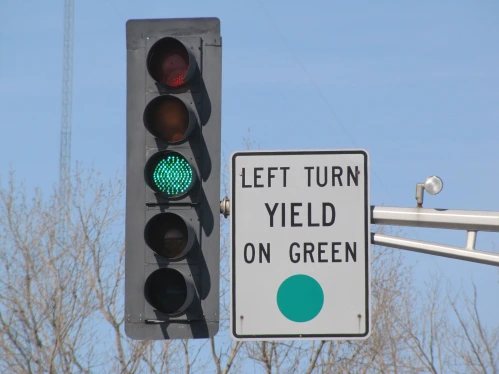
5 lens vertical signal
2) Signals hung from overhead span wires are not used in Minnesota, except in temporary installations (although some, like MN 62 at Hiawatha, persisted for decades for various reasons). MN 36 in Lake Elmo will likely be the same story. These are more common in permanent installations out east, which are usually metal poles, and usually a lot neater than the wood poles that Minnesota slops together. There are also quite a few surviving 4-way signals, some converted to LED. With the requirement of more than one signal head in each direction, these were augmented with two single faces tied together on either side, for a total of two facing each direction. Looking at old photos, Minnesota always seems to have preferred putting them on posts on the side, I’ve never seen a 4-way here.
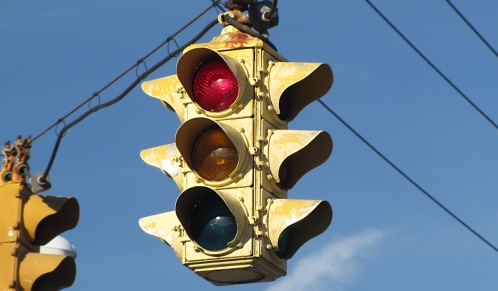
4-Way Signal Cleveland, TN
3) Minnesota always puts signals on the poles on each side of the mast (and these are useful if there’s a truck blocking your overhead view. Other states do not always do this. It might be carried over from masts supplementing side signals in Minnesota, and replacing overhead span wires in other states.
3) Of course, some signals are mounted horizontally elsewhere, as we’ve all seen in Wisconsin (although their new standards are vertical only). These are also common in Texas and Florida.
4) Eagle brand signals are a lot less common elsewhere. Possibly because of their Quad Cities location (stuff cost a lot more to ship in days gone by), Eagle in all its various incarnations, from the 1940’s Eagleluxes up to the 2000’s Bubblebacks, had a virtual monopoly on the signal market. In other areas of the country, Crouse-Hinds (of New York), and Econolite (of southern California) are a lot more common. McCain, a new player making a big splash with boring but functional equipment, is becoming more common both in Minnesota and nationwide.
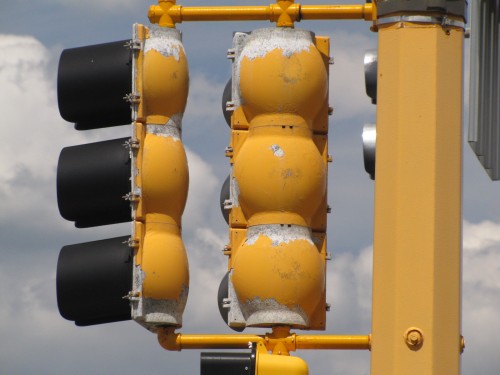
Type SIG “Bubblebacks, later version, 98th and Dupont Ave / I-35W, Bloomington. Eagle visors tend to point downwards more than other brands.
5) Of course other agencies have their own quirks. Obviously there are too many to list, but Chicago DOT does whatever they feel like, nationals standards be damned.
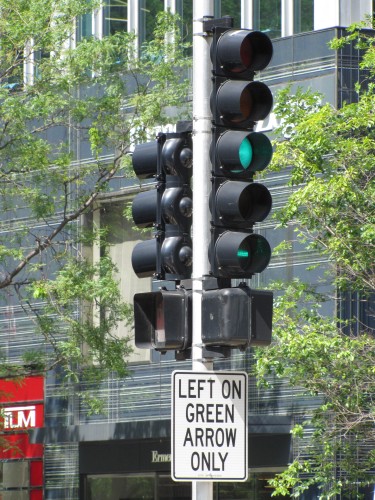
Noncompliant Chicago signal
The US vs Canada
1) The flashing green ball in BC is used at intersections where a pedestrian can stop traffic to cross. The light will flash green until a button is pushed, then solid green, yellow, and red.
In Ontario it has the same meaning as a left turn arrow in the US. In some places the flashing is much faster than in the US. I called them “seizure lights” and my sister called them “disco lights”.
2) Some provinces use square reds and yellow diamonds as assistance to the colorblind. Except for Quebec, they seem to be on their way out.
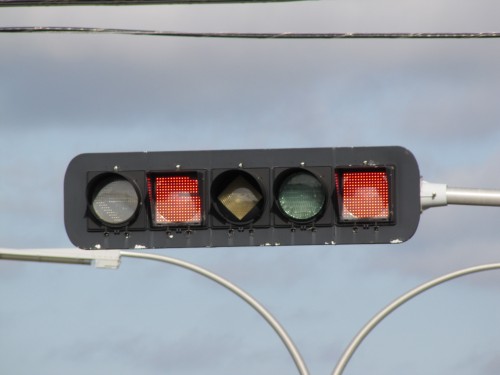
Charlottowne Traffic Light
3) Pedestrian symbols are red and green, and are always outlines (as opposed to the US where they’re now required to be all solid). There’s a subtle difference to the hands, but a large difference to the mans. This one is Canadian standard but is actually in Osseo. A Canadian company called Ecolux was one of the first with LED signals, so some Canadian stuff snuck in down here. Canada also generally uses circular lenses.
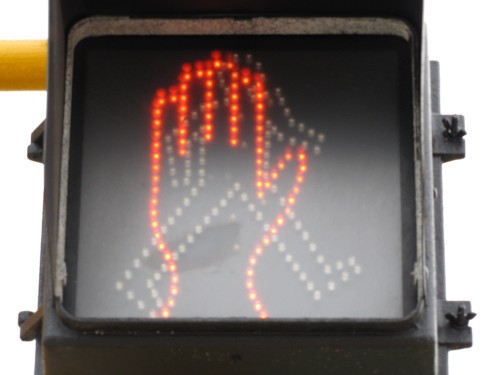
Canadian Standard pedestrian signal in the US
Not really related, but because I think they’re cool, a moose warning sign in New Brunswick, and a stained glass representation of the Confederation Bridge at the visitors center. Tolls on PEI are one way leaving the island, leading to the slogan “You only have to pay if you want to leave”, but still was a bit of a shock paying a $45 bridge toll.

Moose Warning Sign in New Brunswick
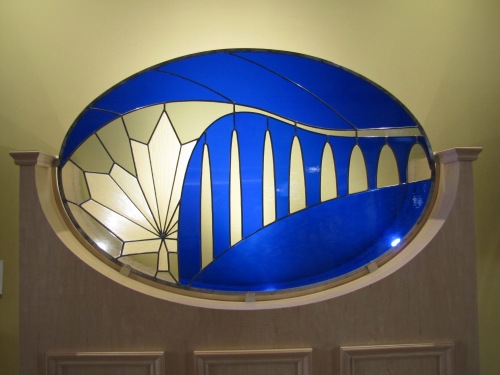
Colored Glass Art of the Confederation Bridge
The Rest of the World
I’ve not been out of the US and Canada since 1985, when I was a child, but here are some of my understandings based on conversations with other road and traffic signal enthusiasts.
1) Fixed time signals are much more common than actuated signals.
2) There’s a much wider variety of configurations, and some vehicle signals have countdown displays until the light turns green light, or until the light turns red. These are specifically banned by the MUTCD on the grounds that studies have shown no benefit, and there’s been suggestions to try to hide pedestrian countdowns from motorists because motorists were looking at them. I’m guilty of that myself. After driving around San Francisco for several days where the vehicle light turns yellow at zero, I angered a truck driver behind me in Grant’s Pass by slowing down where the countdown went to zero with the light still green.
To get vehicle countdowns to work in the US requires technology that hasn’t been implemented here yet. The pedestrian countdowns were designed to “drop in” to existing installations and memorize how long the change interval is, which works because unlike a vehicle signal the pedestrian change interval never varies; there’s no additional wiring beyond the mains wiring for the two indications.


The beautiful “Spiderweb” lenses were only used in the US in the 1940s; they stuck around in Europe

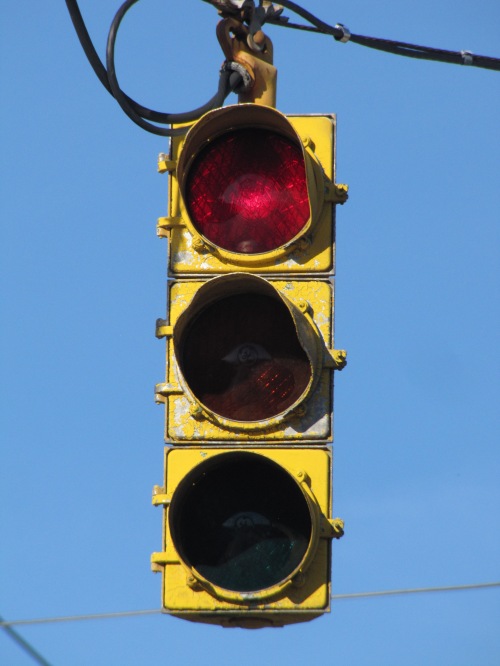
Traffic Signal with GE Spiderweb lens, Cleveland, TN
2) They have stuck with LED look indications, and in turn have developed thinner signal heads that can only accommodate them rather than switching to “incandescent look” modules that require as much depth as an incandescent reflector.
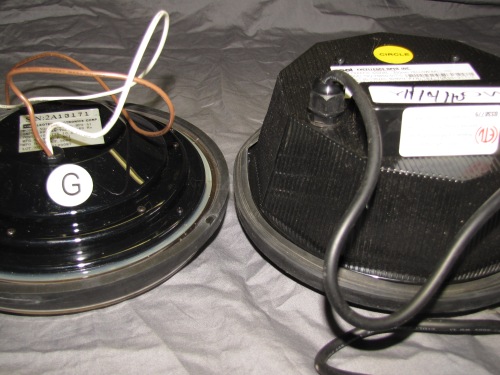
Comparison of module depths
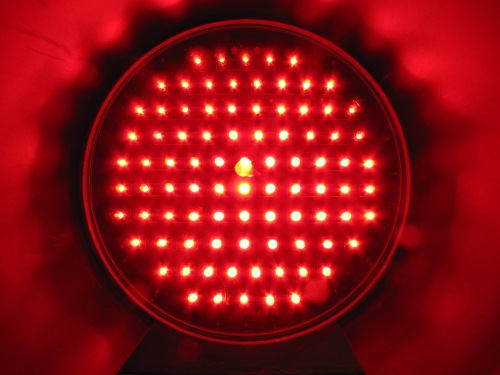
Early Leotek LED module
The famous Ampelmännchen of East Germany.
Animations are common in Asian countries. Notice that the animated pedestrian speeds up and starts “running” as time expires
Uniquely, some German pedestrian push-buttons allow you to play Pong with the person across the street while waiting for a “Walk” signal.
This was actually an ad campaign: people could walk into a booth where their dance moves were copied on the Don’t Walk light, but 81% more pedestrians waited for the light.
Fundamentally too, other countries, including Canada, use red and green for pedestrian signals, instead of orange and white. I covered the development of pedestrian signals earlier, but I’ll repeat, expand,and speculate. In the US the word “Walk” was originally in thin art-deco letters on 8″ round lenses, usually mounted on the same head as vehicle signals.
A green lens would have made it even harder to read across an intersection and possibly be confused with the adjacent green vehicle light. When the orange “Wait” indication was added and moved to a separate head, an orange stripe was added to the top and bottom to make it easy to see and differentiate. The neons, which were a large separate head and one color, were as efficient as another and no way to be mistaken for a vehicle signal, used red and green until they were forced to change. (Red is the “default” color in neon because it is cheaper and lasts longer than other colors). I believe Europe used icons (easier to see) on a separate head from the beginning.
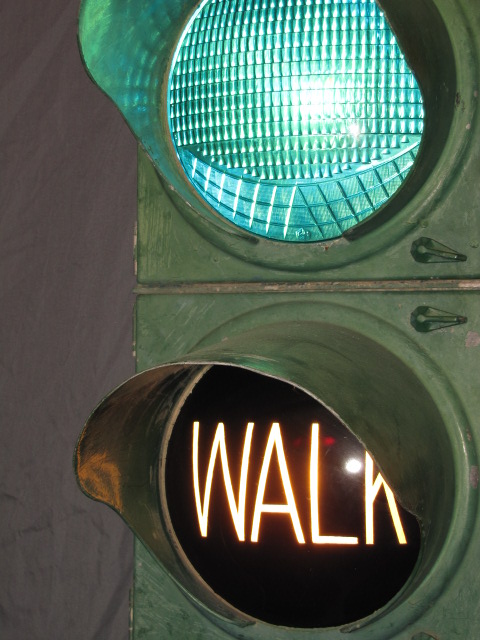
Early pedestrian accommodation, first with the green lens designed to throw some light downward, then with the separate “Walk” lens
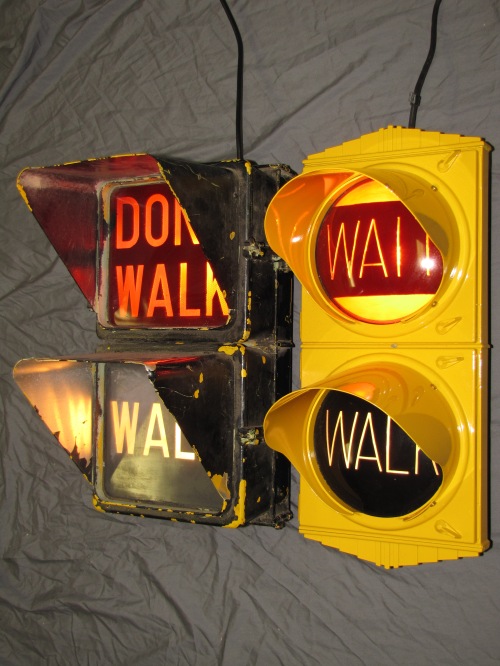
Later evolution to two indication Wait / Walk and then square Walk / Don’t Walks.
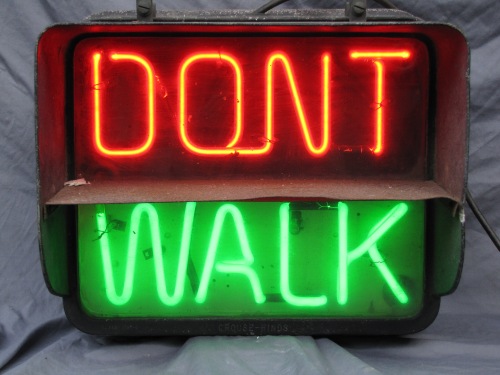
Crouse-Hinds Neon Don’t Walk Signal
4) Some areas have a yellow before the green. This reduces reaction time and gives motorists with manual transmissions (the norm in much of the rest of the world) time to drop the clutch, but can also encourage people to jump the light. Interestingly some early American signals by their design also used a yellow before the green, like the el-cheapo 3-lamp Darley
5) Installations are usually less elaborate than in the US.
6) Right turn on red is prohibited unless specifically allowed. Universal RTOR is one of the legacies of the 1970’s oil crises, the other being the 55 mph speed limit. The first is definitely pro-motorist, the second anti-motorist, so it’s not hard to understand why the first hung around in North America but not the second. Various countries use various means to indicate that a RTOR is allowed. Some use signs and some use signal indications, for example Germany uses a sign and France uses a flashing yellow arrow.

Of course RTOR is controversial in the cities, with some feeling they should be banned and some noting a problem of drivers doing them illegally anyway in places they are banned. And that’s a subject for another article, along with my ideas to make right turns safer and improve LOS for pedestrians.
Common Questions About Traffic Signals
September 15, 2016 at 12:36 am | Posted in Traffic Signals | Leave a commentTags: +Traffic Signal, +Traffic Signal Controller
Here are some random questions and answers about traffic signals that didn’t deserve their own article.
1) What can pedestrian sensors do?
Although pedestrian sensors are uncommon for all the usual reasons (cost, engineers don’t see need, old equipment, etc), there are some neat things they can do. Besides being able to call a pedestrian phase if a pedestrian is present, a second sensor can be mounted pointed toward the crosswalk. This can extend the pedestrian phase if the pedestrian is especially slow. Or conversely terminate it early if it’s a runner or bicyclist. Perhaps by mounting one farther back on a multi-use path they could call a phase if a bicycle or pedestrian is approaching, hopefully giving a walk signal by the time they reach the intersection. The idea is not new; some early ones experimented with pressure sensitive plates, but modern ones use microwave detection.

2) Why do we still have push-buttons if the “Walk” sign always goes on (ped recall)?
This is covered pretty thoroughly in previous articles and my comments to them, but basically ADA (at least as implemented in Minnesota) absolutely requires a station with audible and tactile feedback (in the form of an arrow that vibrates) next to the crosswalk.
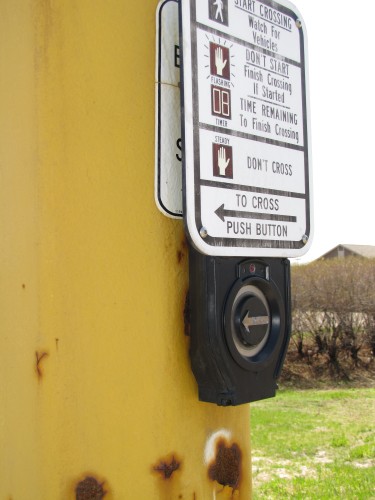
Shiny new audible-tactile push-button on and old signal
First, a station that includes feedback, with all the sophisticated electronics and simply lacking one mechanical button doesn’t make sense, either to produce as a product or for agencies to stock spares for. You’re probably talking about a part that wholesales for a couple of cents for a $400 station that’s part of a $6000 system (and can cost well into five figures to retrofit an existing intersection).
Second, if there was a station without a button, it would still look like it had a button, people would push at it and be confused when it doesn’t move or do anything (if ped recall is enabled or the button has already been pushed the speaker says “Wait”, but it doesn’t affect the cycle.) There’s already a myth that pedestrian buttons don’t “do anything” (that apparently started in New York when they converted from actuated controllers to fixed time and disconnected the buttons without removing them).
The Econolite push-buttons, as used with the famous California neons, would turn a small red light to green to acknowledge that the button had been pushed. This was probably not more widespread due to the maintenance of the incandescent lamps, and has now finally been coming back with the new electronic buttons.
Agencies vary widely in how rapidly they are bringing existing infrastructure into compliance with the ADA. Not just traffic signals, but removing utility poles from the middle of sidewalks.
Guidance in the past has been vague, for example the MUTCD does not require accessible signals, and disability rights groups have in the past conflicted with each other, but finally the FHWA made the statement:
“Implementing regulations for Title II of the ADA, which covers State and local governments, also address “communications and information access,” requiring ‘effective communications’ with persons with disabilities. In the sidewalk/street crossing environment, this would include accessible pedestrian signals, markings and signage.” (FHWA, 2004).
And with the “Public Right-of-Way Accessibility Guidelines” (PROWAG) under development, it is expected accessible pedestrian signals will be mandatory.
But the ADA only requires modifications to existing infrastructure when it can be done without “undue financial or administrative burden.” So far, modifications have been up to the whims of individual agencies and how far disability rights groups want to push things. Minneapolis and Hennepin County, for example, aren’t always using them in new construction. By contrast, MnDOT, which was pushed by disability rights groups, feels they have to include them every time they go smooth out some bumps in the road, and will actually remove crosswalks rather than leave them noncompliant or upgrade them.
3) Why aren’t there more leading pedestrian intervals?
There generally is an impact to motorists, as you more or less double the time they cannot use the intersection (the exception being if the pedestrian phase is long enough and motorists few enough that motorists don’t fully utilize the green time if a pedestrian phase is present), but they are such an advantage to pedestrians that they are beginning to be implemented in areas with heavy pedestrian traffic anyway (one study showed a 60% decrease in vehicle + pedestrian accidents). The MUTCD only specifically allowed them in 2009, so there are the usual issues with older equipment not having the capability, and of resources required to implement them.
One area where I feel a leading pedestrian interval would be appropriate is Berry/Calhoun Parkway and Richfield Road. This has a lead left and in practice pedestrians and bicyclists on the very heavily used trail often jaywalk as soon as the cross street turns red, or at least get confused when they don’t get an immediate walk (It doesn’t help matters that during non-peak period it is permissive only). It would be better as a lag left with recall enabled and a leading pedestrian interval.

Calhoun Parkway and Berry Road
4) Why won’t the light turn to “Walk” if the same direction has a green left turn arrow?
Sometimes it’s just the engineers didn’t think of it and implement it, but this requires the “pedestrian overlap” outputs on the controller be used, not the standard outputs, with associated reprogramming as well as additional load switches. The controller may be old and simply not have that capability. There may be no room in the cabinet for more load switches. Implementing this certainly requires wiring changes in the cabinets. Always much more complicated than setting a menu item on a controller
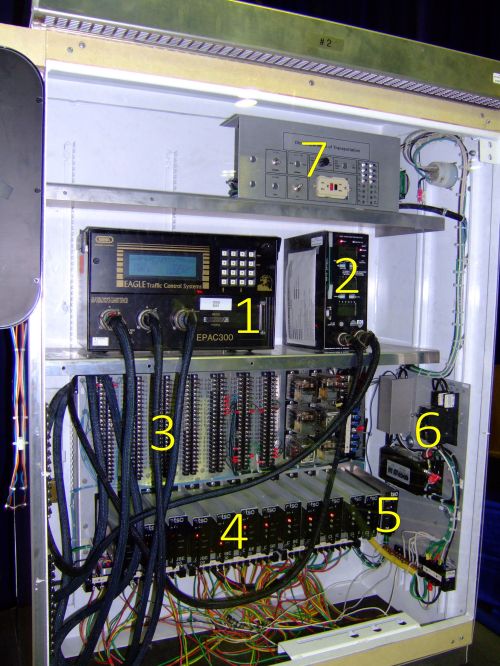
Simple Traffic Controller Cabinet
Here’s a typical cabinet, you can see in #4 that load switches plug directly into the backplane, #3 If there are no empty sockets you basically have to replace the cabinet, probably with a bigger one, and thus probably requiring concrete work… You can’t simply shove an extra load switch in some nook and cranny.
5) Why, when I pull into the turn lane, does the side street turn green first with no one there?
First, it could simply be a fixed timed light where there is no sensing of vehicles. Second, skipping phases where there is no demand is a fairly recent concept. It simply didn’t exist in electro-mechanical or early electronic controllers. So it might be that no one has worked on and upgraded the intersection recently.
Or, the loop detector could be broken, as often happens. If they break they are supposed to default to the “sense” position so calls are always generated.
6) If the cars have the green light why don’t I get a “Walk” signal when I push a button?
“Pedestrian Reservice” does exist and is an option on most modern controllers, but is subject to the minimum pedestrian phase time. You can’t promise the controller “If you give me a Walk, I’ll hurry across.” Since walk intervals tend to be short compared to clearance time, there’s usually not time to give a walk if a pedestrian is not there before or at the beginning of the vehicle phase. Simply extending the vehicle phase until the pedestrian phase can get done would lead to all kinds of issues with coordination. The “Home Depot” intersection previously discussed does have reservice even if it doesn’t have recall to cross the driveway and side street.
To me this is somewhat redundant, since if a phase is long enough to allow ped reservice, it’s long enough to allow ped recall, but the concept does exist.
7) Why don’t signals flash at night or during times of low traffic?
Nothing’s more irritating than coming across a red light late at night when no car is in site. In Minneapolis where there are many fixed time intersections, it can even be a while before it changes. Basically night flash was removed in Minnesota because there have been a number of studies that it’s safer to have full operations 24/7, as well as actuated lights becoming increasingly common. Various studies show a reduction in night-time accidents from 27% to 95% when signals run 24/7. In theory if a light is red, it should turn green as soon as a motorist arrives at 3:00 AM.
As I’ve mentioned repeatedly, engineering fundamentally balances efficiency and safety; Minnesota engineers try to tilt the balance towards safety as opposed to efficiency in a lot of ways, most visibly with how prevalent protected-only turns are (Only in California have I seen more); this balance explains why night flash is extinct in Minnesota. With the increasing number of actuated lights and the introduction of right turn on red, motorists at least don’t have to wait as long as they would have in days past.
8) Can I change a traffic light to green with my TV remote or flashing my headlights?
NO!
Longer answer:-That Youtube video is a myth/prank/joke.
Preemption is triggered by a strobe light mounted on emergency vehicles that flashes at a rate different than what a commercial strobe light will do. After electronic geniuses started building their own triggers, Minnesota specifically outlawed having one in your vehicle (although I have one for my home setup). And in case anyone still has ideas, they’re not easy to build; they require more precision than can be obtained with simple “Electronics 101” type resistor/capacitor timer circuits. Also, they won’t work on the street anyway anymore, because the flashing is now encrypted.
9) What are those blue lights on some traffic signals?
To tell the cops waiting in the next driveway you just ran a red light. The first installation was at the now replaced signal at County 5 and MN 13 in Burnsville and was improvised with a standard industrial fixture; now there are specialized LED lights available. Also, those cameras on top of the signal mast are not “red light cameras,” they’re generally video cameras or microwave sensors for detecting cars, and go no farther than the traffic cabinet. Some MnDOT intersections do have traffic cameras, but they are mounted much higher up.
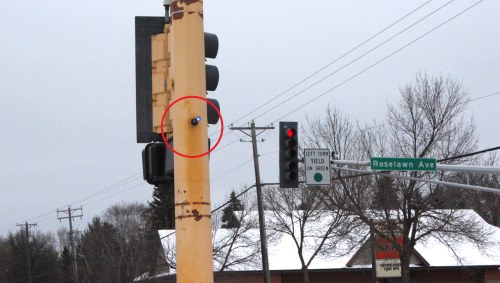
10) What about driver-less cars?
I really am excited about driver-less cars. Imagine being able to start out to Chicago at night, fall asleep, and then arrive in the city with my car in the morning. Imagine editing a post for streets.mn while stuck in traffic. Imagine ordering fast food, or even slow food, on a touch screen and it would be ready when you pull up (and a lot easier and safer to eat in your car). I’d probably eat at Applebee’s instead of Arby’s if it were just as convenient.

But getting back to the topic, think of how fundamentally unchanged the interface between traffic signals and motorists is despite nearly 100 years. A traffic signal controller can only tell if a car is there or not, not how many are there, or how many will be coming it’s way in five minutes. A driver can only see and react to a red light, not know there’s a string of red lights five miles away. So it’s easy to see how revolutionary cars communicating with traffic control equipment could be: No wasted reaction time, signals which know all about traffic and can react accordingly; cars which can reroute if there are a bunch of red lights ahead. Despite frustration with the present, I see great optimism for the future.
How Traffic Signal Controllers Work, Part 2: Programming a Modern Controller and a Look at Their Limitations
September 11, 2016 at 1:34 pm | Posted in Traffic Signals | Leave a commentTags: +Eagle EPAC, +Stoplight, +Traffic Signal, +Traffic Signal Controller
This is Part Two in a series about Traffic Signal Controllers. Part One showed various types of controllers and cabinets, here we continue with a closer look at a 1980s-2000s vintage controller: the Eagle EPAC 300, a 16 phase NEMA (National Electrical Manufacturers Association) TS-1 controller.
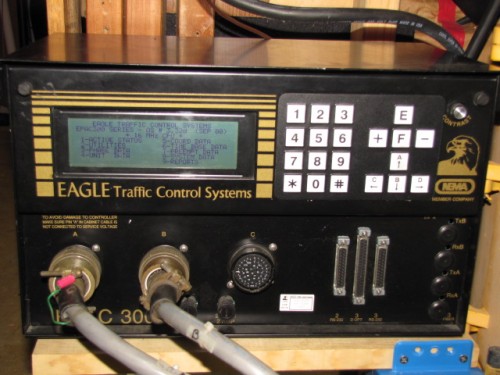
Eagle EPAC Traffic Signal Controller
There’s not much to it on the outside: a membrane keypad and LCD screen for the interface and the “ABC” cables at the bottom for the inputs and outputs. The “A” cable feeds AC power to the controller, DC 24 volts from the controller to run the load switches, and all the inputs and outputs for a simple 2 phase intersection. The “B” cable adds phases three and four, and the “C” cable add phase five through eight. Each wire has a single fuction; there is no serial communication with the cabinet.
To the lower right of the controller are serial connectors for communications equipment, generally to a master controller or a traffic control center. Most newer controllers it’s possible to hook up to a computer with serial connections, and even newer ones may have integrated USB and Ethernet ports, but this is generally only done for initial programming. EPAC stands for Eight Phase Actuated Controller, despite some early units available with only two or four phases, and newer units having 16.
NEMA, conceived in simpler times, only had physical inputs and outputs (I/O) for eight phases. To use more than these, it’s necessary to electronically remap some of the I/O used for other marginal to useless features. NEMA has many features that either were never or are no longer useful; the I/O can be remapped and reused for other things on newer controllers, for instance there is a provision to have a “yellow” light for pedestrian clearance phases. Since instead the “Don’t Walk” is flashed, and these are in the cabinet wired to a the spare center section of the pedestrian load switches, these are normally used to drive things like pre-emption lights and blankout signs. Some controllers also had a proprietary “D” connector for such things.
NEMA controllers can operate by themselves as free-running controllers, or as a master controller that coordinates many of them. The EPAC 300 series is more or less still in production as the M50 and M60, though the Eagle name has been removed and is still owned by Siemens after the Eagle signal head business was sold off to Brown Traffic.
Some of the Screens
Although there are many screens, these can be broken down into (1) “Status” screens, that show what the controller is doing or logs of what it’s done, and (2) “Programming” screens where you enter what you want it to do. I’m omitting anything having to do with: Density and Time of Day Programming (where cycles change based on traffic volume and time), Coordination, Logging, Communication, Start up Sequence, Preemption, and Flash Mode. These are probably of marginal interest to non-engineers, some of these I don’t understand myself, and skipping them eliminates probably 95% of the complexity. Also omitted is anything having to do with actuation. Although some collectors will add video detection and pedestrian push-buttons to their setup (and there’s an amazing variety of buttons to collect), I have chosen not to. I have four phases with two associated pedestrian phases that run in sequence without waiting for calls.
Here is the main screen:
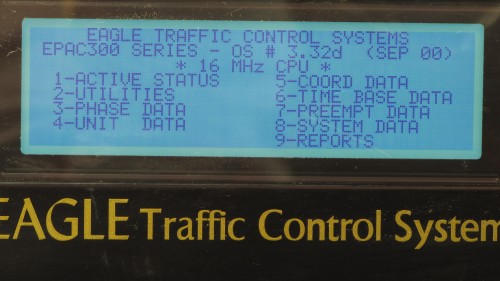
Let’s see what it’s doing first: go to 1-ACTIVE STATUS and then 7-INTERSECTION. The second line shows the phases and then “V-SIG” says they’re all red except phase 4 is green, below that P-SIG pedestrian outputs are “D” for “Don’t Walk” except Phase 4, which “d” means it’s flashing the “Don’t Walk” for the clearance interval. All the phases with physical outputs (1-8) default to red and “Don’t Walk” all the time unless programmed otherwise. In this case 4-8 are not programmed. If there were any Calls, these would be indicated under V-CALL and/or P-CALL. The Overlaps, with letters instead of numbers are additional outputs for driving such things as a protected/permissive display where you have a green ball and green arrow in the same direction. Not all of the vehicle overlaps have designated physical outputs. There are also pedestrian overlaps on a different screen (where you might give a “Walk” signal on one side only if there’s a green arrow the same direction; none of these have physical outputs).
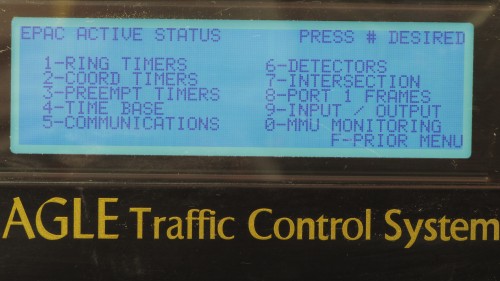
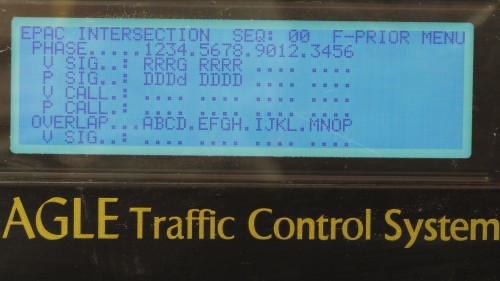
Now suppose we want to play with things and see where values can be entered and changed. Go back to the main screen, select 3-PHASE DATA, then 1-VEHICLE TIMES. The MIN GRN is the green time in seconds for each vehicle phase. Phases 5-8 (and 9-16 on the second screen if you page down) have default values except for the zeros for MIN GRN, which disable them. PASS/10, MAX # 1, and MAX # 2 would extend the green if needed vehicle detection was used, since they’re not here they have no effect and the controllers default values are left in place here. YEL/10 and RED/10 are the yellow and red times in tenths of seconds.
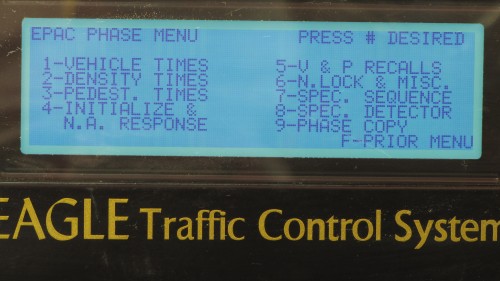
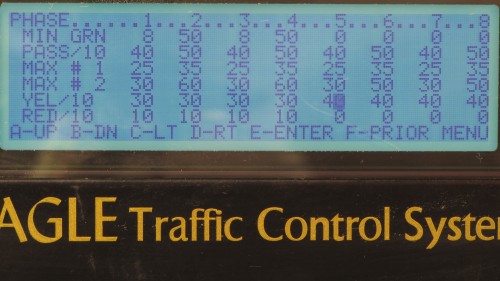
Going back a screen and then to 3-PEDEST. TIMES. Phases 2 and 4 have pedestrian signals hooked up, with WALK time at 30 seconds and PED CLR. at 20 (5-8 will not activate since there are no associated vehicle phases and the numbers you see are default values). The FL WK will flash the walk light, now a MUTCD no-no, but previously used in DC to indicate a crosswalk where there vehicles might attempt to turn across. EXT PCL will continue flashing the “Don’t Walk” through the red and yellow vehicle phases. ACT RIW will hold the phase at “Walk” until a conflicting call come in.
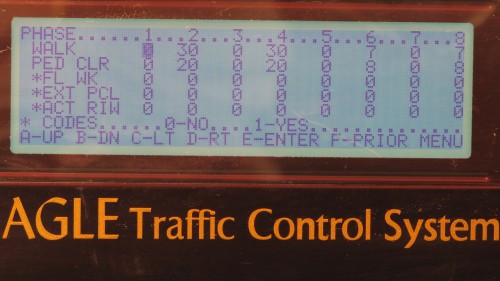
Going back a screen and selecting 5- V&P RECALLS, we see Recall is selected for all four vehicle phases and both associated pedestrian phases (indicated by a “2”) So it will go through the cycle and service all phases without any demand from pedestrian push-buttons or pedestrian sensors. Entering a “1” will generate a call to test the controller in case physical test buttons aren’t provided in the cabinet. DELAY allows you to set a time before Recall is activated.
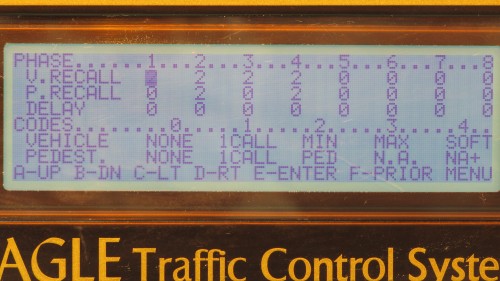
Why Can’t Signals Do What We Want?
Quite often the question gets asked “why can’t a traffic signal do this, or why doesn’t it do that”. Now with a bit of understanding of controllers and cabinets, lets go over a couple of broad reasons why things are or are not done a certain way.
 1) It’s required or banned. The Minnesota Manual on Uniform Traffic Control Devices (MUTCD) based on the federal one with some very minor changes, has options , strong suggestions, and absolute requirements. Engineers are not likely to deviate from suggestions, and may not deviate from requirements. Banning creativity might preclude the best response to a specific situation, but on the flip side road users can expect uniformity nationwide. When traveling, they’re not going to encounter a flashing purple arrow in Peoria or a pink strobe-light in Paducah and then have to try to figure out what those mean. If a city really wants to try something new out, say a red arrow on top of a standard three light signal to emphasize no turns on red (not currently a legal configuration), they can apply for permission to experiment, do a study, and then either remove it if a study shows no benefit, or it may be adopted into the MUTCD if it does.
1) It’s required or banned. The Minnesota Manual on Uniform Traffic Control Devices (MUTCD) based on the federal one with some very minor changes, has options , strong suggestions, and absolute requirements. Engineers are not likely to deviate from suggestions, and may not deviate from requirements. Banning creativity might preclude the best response to a specific situation, but on the flip side road users can expect uniformity nationwide. When traveling, they’re not going to encounter a flashing purple arrow in Peoria or a pink strobe-light in Paducah and then have to try to figure out what those mean. If a city really wants to try something new out, say a red arrow on top of a standard three light signal to emphasize no turns on red (not currently a legal configuration), they can apply for permission to experiment, do a study, and then either remove it if a study shows no benefit, or it may be adopted into the MUTCD if it does.
2) It’s often a zero or negative sum game with intersection capacity a fixed resource, since pedestrians and motorists compete for the same resource, and the needs are completely opposite. Right on red or longer overall cycle times: pro-motorist, anti-pedestrian. Exclusive walk phase or leading pedestrian intervals: anti-motorist, pro pedestrian. Other people may not see it this way, and are surprised when I describe “pedestrian improvements” as “anti-motorist”, but ultimately that’s the effect even though there may have been intent to harm vehicle operations (although sometimes there is). Additionally since pedestrians move a lot slower, sometimes a very modest benefit for pedestrians can produce an extremely severe impact for motorists, like ped recall across a wide suburban-style road. More details on some of these scenarios will be in the next part.
3) A lot of equipment on the field is very old. Even computerized controllers tend to use 1980s vintage microprocessors like the Motorola 86040, and the need for standardization dampens innovation. This is more true in the cities were demand for pedestrian amenities is greater. Until very recently Minneapolis even had electro-mechanical controllers. Old controllers may not have the capabilities that people want. But it still works and cities are not made of money. In some cases even what seems like a minor change could require a complete cabinet replacement, or even a bigger cabinet requiring a bigger concrete pad and redoing a lot of the wiring, and the cities are not likely to do that just because someone wants a leading pedestrian interval or something.
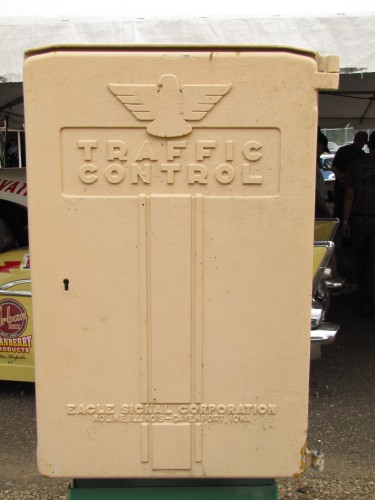
Eagle Electromechanical Traffic Signal Controller Cabinet
Although we’ve come a long ways from a free-running E/M controller in every light, even the newest controllers are nowhere near as powerful as a PC. (You may have noticed the line “16 MHz CPU” and a 2000 firmware date on the main screen of mine.) Even if they were, in most situations the input and output are still limited, with the only input available being vehicle sensors and pedestrian buttons and only output being lights. They can’t look at a a bunch of cameras focused on the intersection and down the block and make decisions based on it, or sound a fog horn if they see a motorist inching into the crosswalk. Things are getting better with multiple vehicle sensors that can thus measure vehicle speed (one controller even has a “feature” that will turn the light red if an approaching motorist is speeding) and the new Linux based controllers that are more flexible in certain ways.

Sometime upgrading the firmware on existing equipment is possible, but besides the expense and need to go out and swap out chips or update the flash memory, engineers like to have known, stable, and consistent firmware. At least once Mn/DOT has had to back out and revert to an earlier firmware version because of bugs. Mine is running 2000 firmware and would require an upgrade to do leading pedestrian intervals.
There is also the “SMART” Signal system, which tries to harvest and aggregate data gathered by standard controllers together using industrial PCs and use it to dynamically optimize timing in a way that’s not possible with traditional manual coordination. The controller is an Econolite ASC series, the Mn/DOT standard and most widely used in Minnesota.
4) Old-Fashioned engineers. To end with the elephant in the room, sometimes it really is engineers that are just set in their ways and not taking the needs of pedestrians seriously or being open to modern ways of doing things. And it’s not just signals; they admitted the trails associated with the St. Croix Crossing are only worked on “as we have time”. And closed down the sidewalk on the Hastings Bridge for the entire duration of the project even when there was no work being done anywhere close to it. However the point I’m trying to make is there usually more too it than some “dumb engineer sitting in a chair in Medina” not wanting to put down his donut in order to click an icon on the computer in front of him.
Overall, the idea isn’t to pass value judgments or state my opinions on what is or is not a worthwhile change, even though perhaps the fact that 95% of the time I’m a motorist shows through. Rather, what I’m trying to do is lay out the reason things are the way they are.
How Traffic Signal Controllers Work, Part 1: An Overview of Controllers
September 10, 2016 at 2:37 pm | Posted in Traffic Signals | Leave a commentTags: +Crouse-Hinds, +Stoplight, +Traffic Signal, +Traffic Signal Controller
Electro-mechanical Controllers.
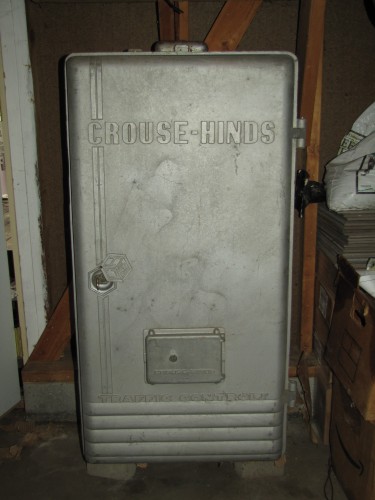
Crouse-HInds PCE-3000 E/M controller.
Electro-mechanical controllers date from the beginning of traffic signals up to new installations in New York City into the 2000s. I’ve placed a few short videos below, and there really is no substitution for viewing them to get a sense of how them parts move, but here’s a description and some still pictures first.
1) A dial with keys on it rotates, very much like a mechanical timer. Some used multiple dials for different timings on different times of day. The speed of the rotation is controlled by different gears that can be installed.
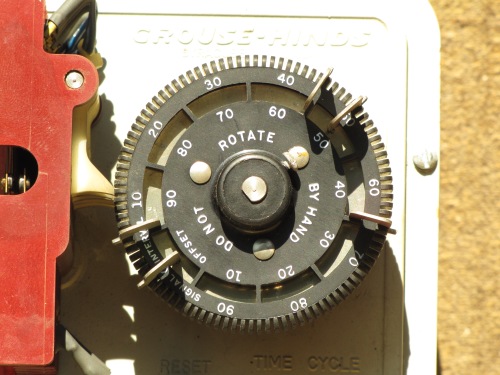
Dial and Keys
2) As the keys pass a micro-switch they temporarily close it to activates a solenoid or motor. The motor rotates a camshaft with cams. Each cam has lobes that can be moved or broken off around the perimeter. The knobs hold an array of piano switches open. Removing a lobe causes an individual switch to close when the cam is in that position. Each signal indication on each street is wired to one of these switches.
This is the simplest possible installation, a two phase, no red clearance operation. The first key changes Main Street green to Main Street yellow, the second changes Main Street yellow to red and Side Street red to green, and so on. The key in the middle prevents the cams from getting out of sync by not allowing it to advance unless it hits a switch.
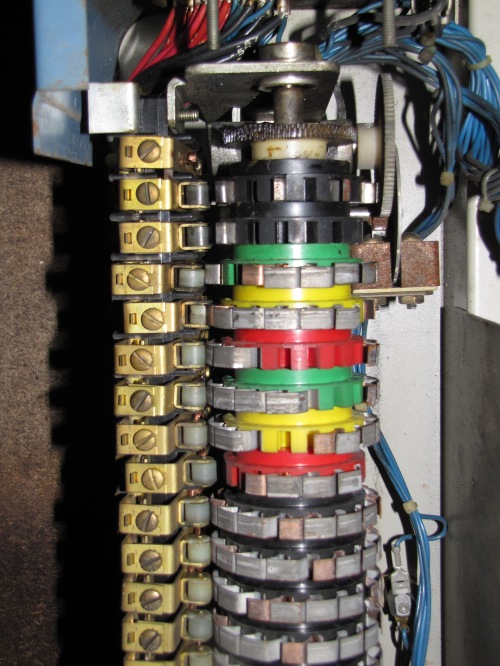
Camshaft, Cams, and Switches. Note some switches are in the closed position due to the metal lobes being removed from the cam, and some of the cams are color coded. Here the Main Street Green and Side Street red switches are closed and thus the lights would be lit.
Coordination is actually possible with E/M controllers. A mains wire runs from one controller to another, and a relay removes AC power to the controller downstream to prevent it from getting out of synch.
Video 1: Shows the outside of the controller
Video 2: Shows the inside and the dial rotating:
Video 3: Shows the dial, then the cams
Video 4: Closeup of the cams
This area tended to use Eagle E/M controllers. Crouse-Hinds controllers like mine (from probably the early 1970s in Moberly, MO), used motors instead of solenoids creating a whir instead of a clunk when moving the cams. Also, the cams have metal lobes that are replaceable, so if you make a mistake arranging cams or want to change things you can. With Eagle and other brands if you break a lobe off that’s it, you need to replace the entire cam to undo it. Cams are still available from one supplier, but there’s talk from signal collectors at having them 3D printed due to the expense and hassle of working with distributors.
In some ways E/M controllers can be even more flexible than early electronic ones. There’s no reason you couldn’t “program” leading pedestrian intervals or even flashing yellow arrows, something early electronic controllers are not capable of.
Hybrid Controllers
E/M Controllers may work well for fixed time applications, but they did not really handle actuation (where they respond to serve a vehicle or pedestrian phase). This was more important with the rise of the suburbs, where traffic demand is less predictable and fewer traffic signals exist, rendering fixed time inefficient. Basically the timing was generated by vacuum tube electronics charging an absolutely huge oil filled capacitor, which would eventually discharge through the solenoid, moving the cams. The rate of charging, and thus timing was controlled by knobs on the front which are variable resistors.
Other items in an E/M or hybrid cabinet might include E/M timers to switch dials or put the cabinet in night flash, an E/M or electronic flasher, and transfer relays.
Electronic Controllers.
The first electronic controllers were designed as drop-in replacements for E/M controllers and used a lot of the same terminology and philosophy. The times were set by knobs and dip switches and such and each brand was proprietary. Gradually a standard (NEMA TS-1) was implemented to the connector from brand A was the same and each wire would do the same as brand B, and certain functionality was required, so you wouldn’t have to essentially replace the cabinet to switch controller brands. Later controllers went to a keypad with a few numeric LEDs, to program them you’d look up on the manual something like “Function 132 Main Street green time”. Later LCD displays were much more user friendly. Philisophically there was a switch from “percentage of dial times’ to programming in phases.
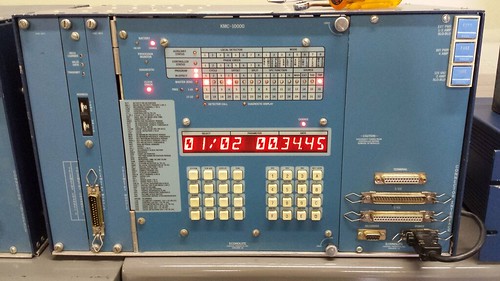 +
+
There are a few traffic signal collectors that tinker with these early controllers. Very few. Some of the flashing LED displays are fun to watch, but the connectors and documentation are hard to find, electronics do not age well, especially when unplugged for extended periods of time, and newer, much more user friendly, reliable and versatile models are available at attractive prices. So collectors usually use newer electronic models, or else old cool E/M ones.
Electronic Controller Cabinets
Here is a simple demonstration cabinet with the components annotated.

Simple Traffic Controller Cabinet
1) The controller itself: The actual controller. Inputs and outputs are 24 volts DC,
2) The conflict monitor: makes sure that the controller doesn’t mess up and do something like turn both directions green. If it detects something like this of if the controller fails, it will put the signals into flash
3) The back panel- contains the terminal blocks (towards the left), flash transfer relays (towards the right), and sockets for the load switches and flasher (towards the bottom)
4) The load switches: These take the 24 volt outputs of the controller and control the mains electricity to the signals themselves, essentially solid state relays. Each load switch can control up to three indications, generally the red, green, and yellow of a single direction.
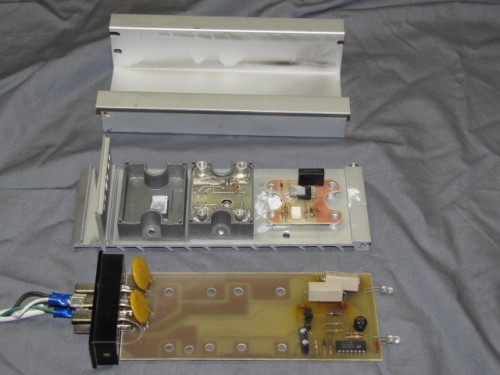
NEMA Flasher Module. the load switch is similar but has a third solid state switch module instead of components on the main board.
5) The flasher: Generates a flashing signal independent of the controller, so the signals can still flash if the controller itself goes down.
6) Circuit breakers and power filters
7) Manual control and test switches
In the real world it would likely be jammed full of equipment. The second shelf would have fiber optic communications equipment and pre-emption equipment, the manual controls would be mounted to the door and the top shelf filled with loop amplifiers or video detection equipment.
A newer standard is TS-2, which replaces some of the hard wiring with serial connections. Also available are 2070 cabinets, where the hardware is purchased separately from the software, and the controller is more modular, accepting various function cards. Minneapolis uses 2070 cabinets, the other agencies use NEMA. The newest controllers are ATC, which combine some of the elements of NEMA and 2070 controllers and run on standard Linux, enabling more flexibility with software programs.
My Own Collection:
Here is my home setup. It’s a four phase sequential setup. It lacks a conflict monitor (they are difficult to wire and in a home setup serve no real purpose unless you own a real cabinet, in which case it’s a pain to rewire the whole thing to not need one). Beyond the bare minimum to run some lights (controller, cable, load switches) it has a flasher and flash transfer relay, and some manual switches to put it into flash mode. The controller is an Eagle EPAC 300. Despite using Eagle signal heads, their controllers are not really used in this area. The EPAC series is a favorite of collectors since it’s (relatively) simple, new enough to be reliable but not too new to be complicated and expensive, and other collectors use them so help programming is available. I know there’s exposed wiring, but it’s semi-protected and is in the basement where the pets don’t go.
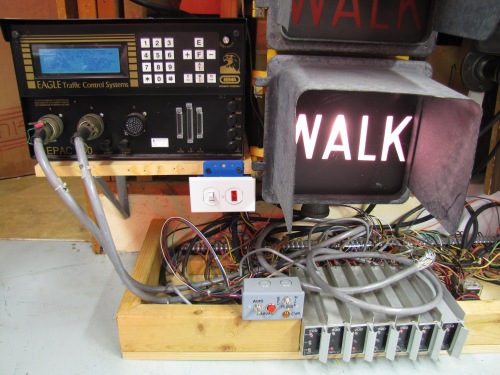
Home Setup
The controller I got for $75, and the load switches I got eight for $50 on eBay. Surplus dealers will buy a bunch of stuff at municipal auctions and try to flip them, not knowing that they’re essentially worthless unless an occasional collector wants one. No city is going to buy a 20 year old controller off eBay. Unfortunately the sellers can’t test the equipment and sell it “as-is”; they can’t even plug it in to see if it powers up because there’s no standard AC power cable, and it may be password protected which would require new firmware to clear.
The cables are by far the hardest to find because they tend to stay with the cabinet and get discarded when the cabinet is recycled, new bare connectors are close to $100 from electronics suppliers. I finally got some cables from another collector who is also a real signal tech. Obviously some knowledge of electronics and ability to work with mains current safely is required. But of the 175 pins on the three connectors, I’m only using less than three dozen, and a simple setup with two phases can get by with as little as 14. (10 outputs, one for each signal light, AC power, neutral and ground inputs, and 24 volt output to the load switches.)
I’ve used a bunch of terminal blocks from a local surplus store for much of the wiring. The load switches are designed to plug into Jones sockets in cabinets, but with a little coaxing they will accept standard female spade lugs. Load switches aren’t especially expensive or hard to find, but a bunch of 24 volt relays can also be used. Wires to the signals are 4, 5, and 7 conductor “SOOW” cable, usually used for wiring industrial equipment.
Home Controllers
It should be mentioned that all this is way overkill if you just want a traffic light in your garage or man cave. Single board controllers are available that will drive a single signal and are easy to use. All that is involved is wiring a mains cord to the controller board, then each of the three lights to the board. The 150 watt rating is good enough for any signal, even a 3M. Some serious signal collectors will use these too; some of them have no interest in real controllers, and may have signals scattered through their property instead of a single “signal saloon”. The main problem with these is there’s no protection on the output circuitry like a real load switch; a bulb burning out can occasionally damage them.
Finally, a video of my setup in operation. I have fairly broad tastes (as broad as signal collecting can be) with stuff ranging from 1940s art deco signals to modern but unusual stuff to examples of signals common to this area with an interest in both lenses and LEDs and a particular interest in pedestrian signals.
Since I know people are wondering: Most of the signals I got from eBay or other collectors. The cheapest one was $25 (the St. Paul Durasig pedestrian signal); I have over $1000 invested in obtaining and restoring the neon pedestrian signal. Some collectors have bought new from distributors, but understandably they tend not to be friendly to collectors. They’re intrigued by the interest private collectors show, but at the same time they have a job to do and are more interested in a city that might buy 500 as opposed to some guy that wants one for his basement, and then decides it’s too expensive when he finds out the cost.
Some Sign and Signal Fails
September 9, 2016 at 3:33 am | Posted in Traffic Signals | Leave a commentTags: +3M Traffic Signal, +Signal Fail, +Traffic Signal
Here’s some Sign and Signal Fails (as well as some that are simply unusual) from around the state.

Irish Traffic Signals?
I can understand getting one sign upside down (well, no I can’t, but whatever, but three of them in the same area? These were when US 212 was being built around Prairie Center Drive.
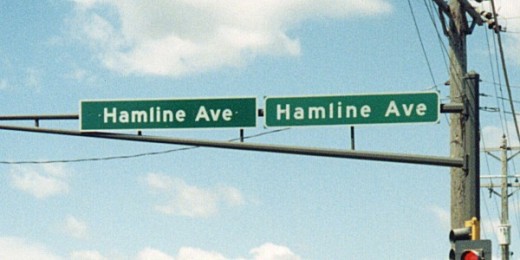
Is this Hamline Ave or Hamline Ave?
No question what the name of this street is.
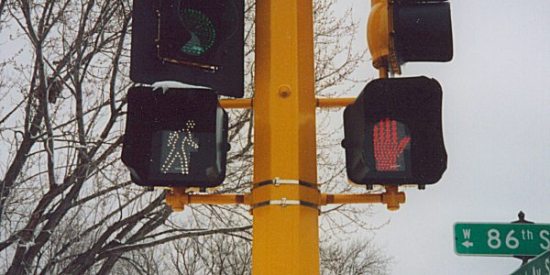
Walk or Wait
These signals are sending a mixed message. Likely the one on the right got twisted into the wrong direction by a snowplow
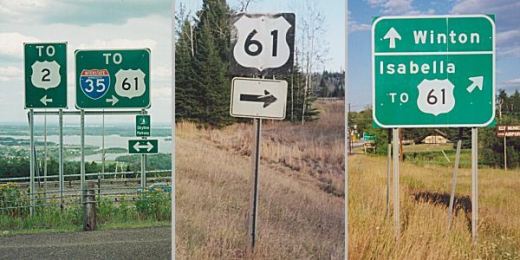
Surplus 61 Shields
When US 61 became MN 61 they missed a couple in out of the way locations; these were years after the change. I believe these have finally been replaced.
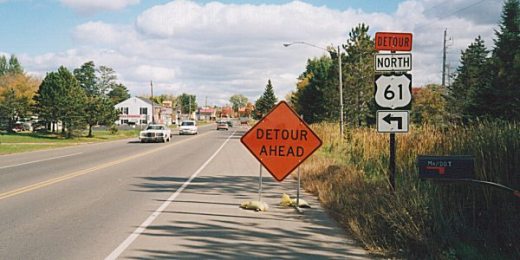
A little late
This sign was made decades after US 61 had been removed from this road, I guess the locals still call it “Old 61”
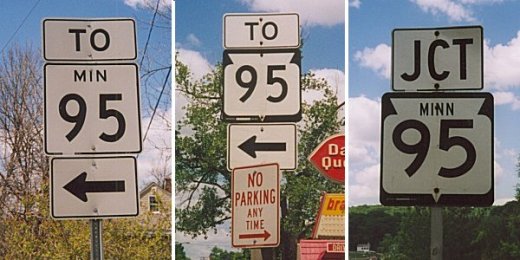
In Wisconsin…
These have all been replaced with real MN route markers.
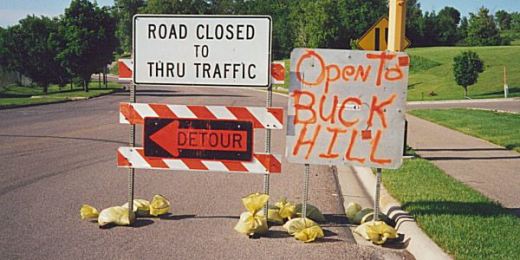
Sloppy Contractor Work
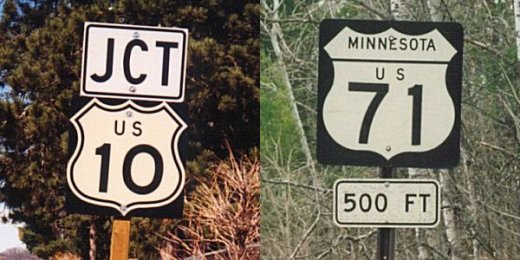
Some Interesting shields
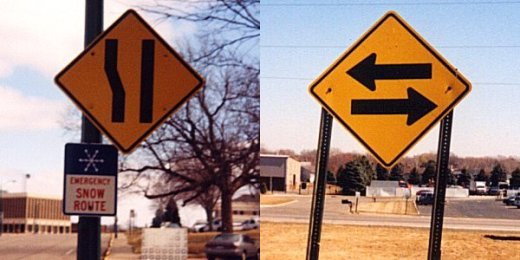
Signs mounted funny to alter their intended meaning
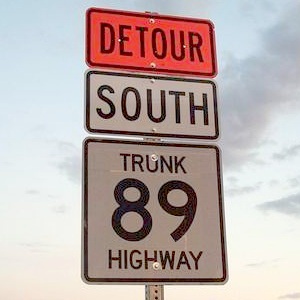
Another contractor innovation. Photo by Andrew Filer
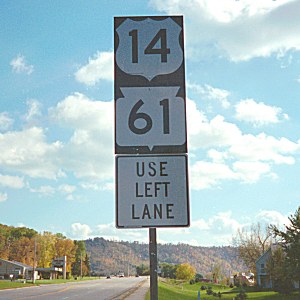
Wisconsin and US markers are so similar that screw-ups are almost non-notable
Is it a Ball or an Arrow?
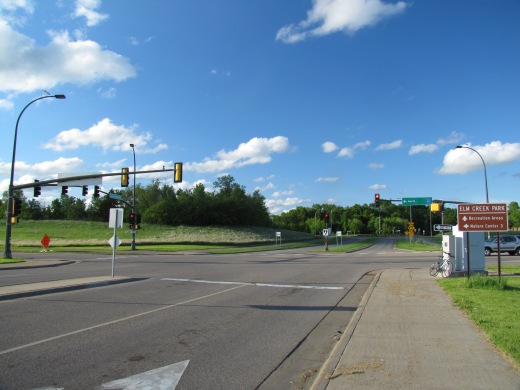
Elm Creek Blvd and County 81
Not a fail, but interesting. This intersection of County 81 and Elm Creek Boulevard doesn’t seem to be particularly interesting, but look closer when the light turns green. Then move closer.
The green ball magically changes to an up arrow! 3M, in addition to common balls and arrows and much less common pedestrian lenses, had all kinds of special contraptions for use in their Model 131 programmable visibility signals. One of these was a bimodal indication that would show a ball from a distance and and an arrow up close.
The reason for this is that balls are much easier to see from a distance. Once drivers approach the intersection, however, it changes to an arrow to direct the driver where to go. At County 81 and Elm Creek Blvd., the eastbound and westbound lanes are widely separated by MN 610. What you have is a one way with 70 mph traffic in a place you wouldn’t expect one. Using only left and up arrows reinforces the point that you are absolutely not supposed to turn right.
Like most of 3M’s odd stuff, these bimodal indications are extremely rare. Only one is known to exist in a private collection and only a couple are known to exist on the street. Here’s a video of what you see as you approach, in a car the transition would be much faster.
A Danger to Pedestrians
At the same signal, facing the other way is a problem. Ten points to whoever can instantly see what is wrong with this:
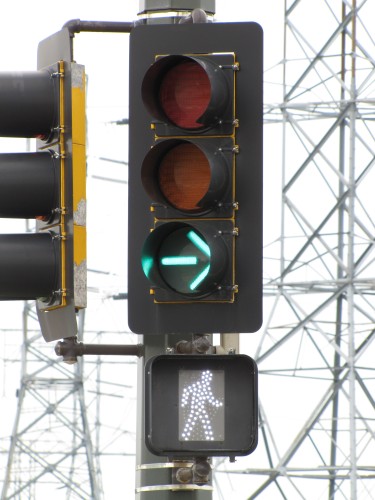
Elm Creek Blvd and County 81
Although this configuration is allowed by the Minnesota MUTCD 4D.4 #2 and #4, (which states that pedestrians may enter against a green arrow when indicated and drivers following an arrow must yield to pedestrians lawfully in the intersection) that doesn’t mean this is a good idea. Most drivers and pedestrians aren’t in the habit of reading obscure sections of the MUTCD or state statutes for exceptions to normal rules, and on the surface this signal is telling both motorists and pedestrians simultaneously they have the right of way.
As for fixing it, one option is to just replace it with a standard green ball, and lose the extra feedback the signals provide to keep drivers from turning in the wrong direction. Probably a better option is a flashing yellow arrow right turn signal, that would give a green arrow under normal conditions, and a flashing yellow arrow during a pedestrian phase (this light was installed before this option existed). Although a red ball mated to a flashing yellow arrow is an illegal configuration, state law allows a placement of a sign allowing turns on red arrows after a stop, so that’s what I’d do here.
Since this intersection operates in split phase, there is nothing wrong with the 3M arrows facing north since the west crosswalk will never have a walk while northbound traffic has a green.
OOPS!
For want of an unrusted bolt, this this signal failed.
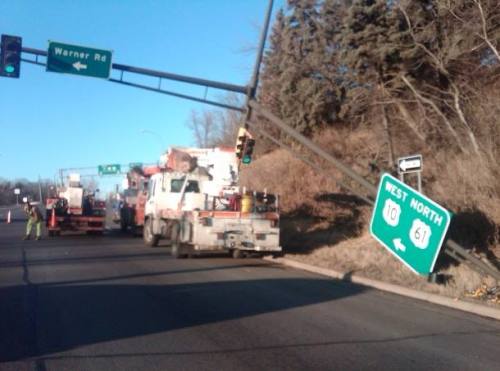
Signal Fail
Signal Fail
More subtly, do you see anything wrong with the black signal on the right?
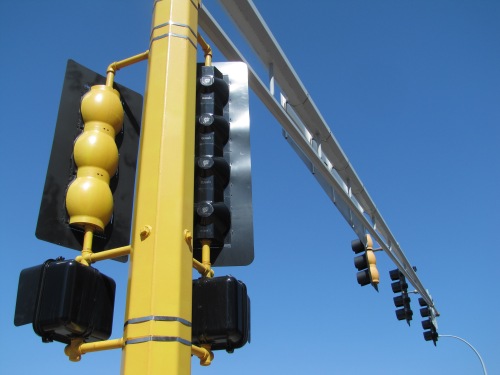
Silver Bell Road and Cedar Grove Blvd, Eagan
How about now…
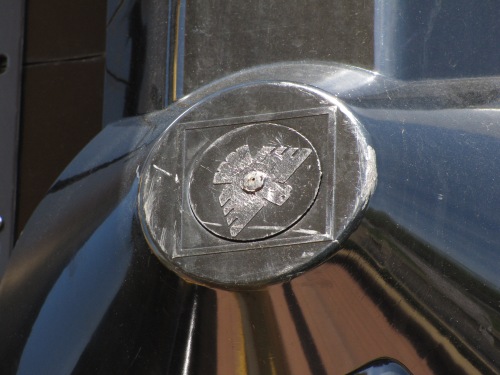
Yes, this picture is right-side up. The “dive-bombing” Eagle logo
This was a mistake during an entire production run. The companies official line is “China sent us a bad mold but the signals themselves are as usual, the highest quality”. Now that Siemens has spun off its traffic signal head business to Brown Traffic, they plan to replace the Eagle “thunderbird” logo (which somehow never got removed from these during the entire time Siemens owned it), with their new Eagle logo.
Looks like someone is going to lose a game of “3M Jenga”.
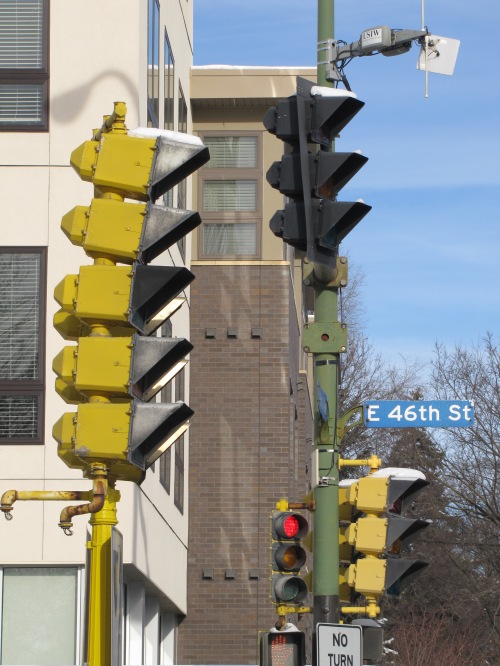
Signal Fail at 46th St. and 46th Ave, Minneapolis
Old brittle poly signals + wind
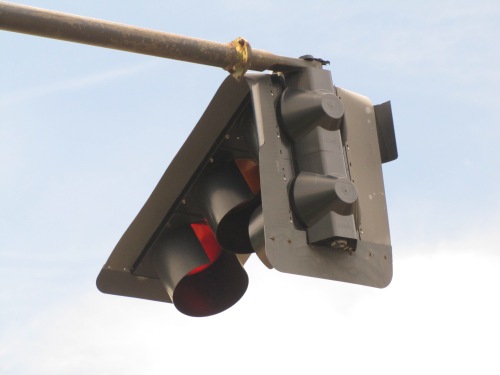
Signal Fail at W Lake Street and Thomas Ave, Minneapolis
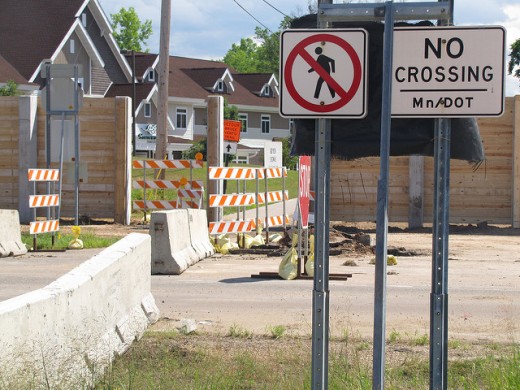
The space between the jersey barriers is a temporary pedestrian crossing. Note the “No Crossing” signs that weren’t removed.
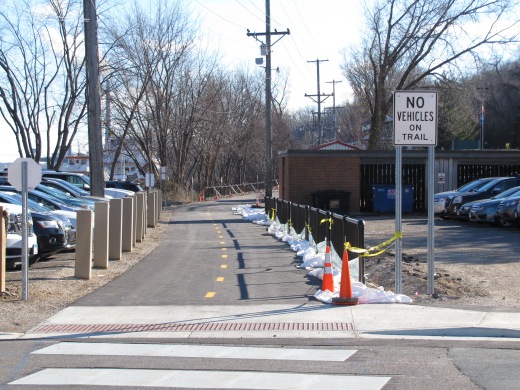
This one’s kind of subtle. Remember a bicycle is a vehicle
A History of Pedestrian Signals
September 5, 2016 at 3:03 pm | Posted in Traffic Signals | Leave a commentTags: +Don't Walk, +Neon Traffic Signal, +Pedestrian Signal, +Stoplight, +Traffic Signal
Early Days.
Since almost the beginning it was recognized that additional accommodations needed to be made to pedestrians. As early as 1930 federal standards encouraged signals at the corners of the intersections, where they could easily be seen by pedestrians and cars alike, however in practice agencies would go the cheap route and hang a single stoplight over the center of the intersection. (Earlier I mentioned the Darley, the ultimate in cheap, which used only three bulbs and had a simple, integrated controller). Such a signal would be hard to see by pedestrians and traffic near the intersection alike (in fact there were gizmos that consisted of a prism to be mounted to your rear-view mirror to make it easier to see overhead signals). As a rudimentary accommodation, the Crouse-Hinds “Smiley Face” lenses came out, that were especially designed to throw light down.
Later, encouraged by traffic signal companies that wanted to sell more segments, a separate white on black “Walk” indication was introduced. Typically they would be added to the bottom of an existing signal.

Early pedestrian accommodation, first with the green lens designed to throw some light downward, then with the separate “Walk” lens
Orange and White vs Red and Green
From the early days orange and white were standard for pedestrian indications, but red and green were also used. Also, later on some of the whites were modified to “lunar white”, by using a light blue filter over the yellowish incandescent lamps. The theory is that this made the white color more distinctive as opposed to all the other incandescent lamps around, but it decreased the overall brightness, and was never universally adopted until the LED era, with LEDs being naturally lunar white. There was also experiments with aqua blue “Walk” lenses that never caught on, nor were officially sanctioned.
Further improvements.
8″ circular lenses were hard to read across increasingly wide streets, so 9″ square lenses were introduced, mounted on adapter sections that attached to the bodies of standard vehicular sections. With the advent of 12″ vehicle signals the pedestrian signals grew also, although for many years it was common to have 9″ pedestrian signals with 12″ vehicle signals.
In 1961 “Wait” was replaced by “Don’t Walk”, and flashing the clearance interval was introduced. Telling pedestrians what to do rather than what not to do was seen as more direct (and audible pedestrian buttons still say “Wait”), but “Walk” and “Wait” looked similar enough to be confused on a small lens across the intersection. People being like the are, pedestrians tended to notice how long the clearance interval and buffer were, and would start walking on the “Wait” indication, sometimes with very little time actually left. Flashing the clearance and thus separating it from the buffer gave differentiation to what in reality meant “start walking if you can move fast” and “get out of the intersection now”. The later introductions of countdowns gave further feedback as to exactly how much time they had.
As a side note, there used to exist flashing “Walk”s, and most controllers have a setting for selecting it. Notably Washington DC would use to to indicate when permissive vehicle turns were allowed to cross the crosswalk, and thus for pedestrians to be on the lookout for cars failing to yield.

Later evolution to two indication Wait / Walk and then square Walk / Don’t Walks.
The California Neons
Although used in other warm climates and New York, neon pedestrian signals are most associtated with California. The original versions had an red “Wait” and green “Walk” spelled out in neon in very heavy casting. Later models were lighter weight, spelled Don’t Walk and “Walk”, and were bimodal- the clear red tubing was overlaid on top of the opaque green tubing resulting in the “Walk” being able to light up two colors. This was the only model of pedestrian signal ever to have the correct apostrophe in “Don’t”. In the early 1970s new California standards required standard lettering rather than spelled out in neon, so plastic lenses were backlit with neon, and the colors changed to orange and lunar white.

Below is a classic bimodal “Walk / Don’t Walk in operation
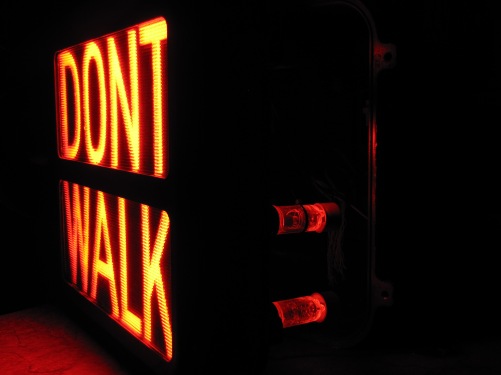
Newer Backlit E8 Neon Pedestrian Signal

Internal view of the Econolite “E8” neons. The black boxes to the right are the high voltage (5,000 and 9,500 volt) transformers for the tubing, which is contained in the metal trays mounted to the door.
The hot dry climate of California was ideal for neon, and many existed from the 1980s up to the last one being converted to LED in 2012. By contrast in New York the cold affected the “Walk” tubing . The “Don’t Walk”s were filled with neon, but the “Walks were filled with mercury/argon, similar to a fluorescent lamp, and with the same dimness problem in cold weather. And the high voltage tended to short out in humid climates like Florida.
As a competitor to Econolite, a company called Indicator Control Corporation began by making their own neon signals in the 1970s. Originally these still had heavy transformers, but the neon tubing was in a sealed plastic “modular” unit. Later the magnetic transformers were replaced by switching power supplies and also incorporated within the modules, so maintaining neon became as easy as a modern LED; just toss the entire defective module and put a new one in. Notably, ICC introduced the standard 16″ by 18″ form factor that is still with us today.
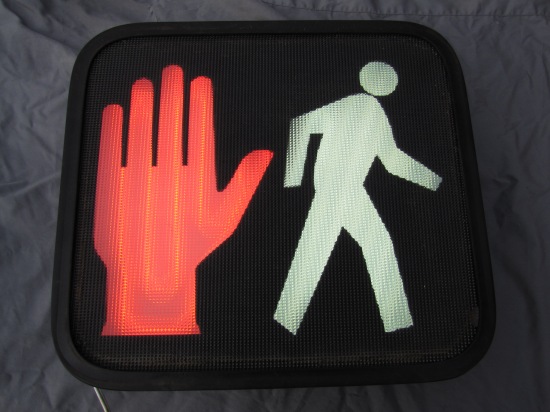
ICC Neon module removed from external housing. These are about the same size and can be used like LED modules.
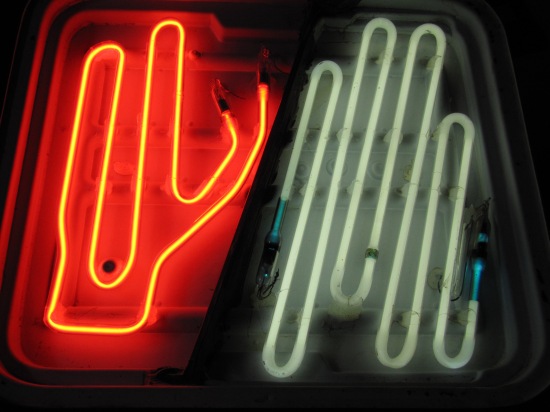
ICC module with cover removed. The power supplies have been reduced to small circuit boards behind not visable behind the tubing rather than huge, heavy transformers.
Incandescent Bimodals
The neon signals had the advantage of being large and easy to see, however they were expensive and did not perform well in cold weather. As an alternative some companies made bimodal signals that were back-lit with incandescent bulbs; the “Don’t Walk” would light up red or orange, and then only the “Walk” would light up green or white. The Marbelite LPS-20 was one example. The lamps for the “Don’t Walk” indications were 65 volts and wired in series so if one burned out the signal would not light up with an orange “Walk”. (These bulbs are now completely unobtainable, and collectors that don’t have working original lamps need to rewire their signals to accept regular voltage bulbs). Unfortunately the plastic reflectors would get brittle and break, and even catch on fire. (Wink-O-Matic signals also had problematic plastic reflectors). Later Marbelite released the MPS-20 using the same casing that had separate sections for the “Walk” and “Don’t Walk” using metal reflectors. Other companies like ASI and E-Man had casings of cheap stamped aluminum instead of cast, but at least had metal reflectors.
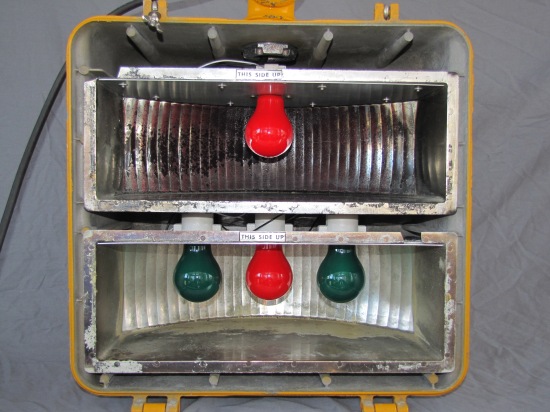
nternal view of the LPS-20. The metal plates inside were done to repair the reflectors, which had broken under the weight of the sockets while being shipped
As a side note, a fellow collector came up with a LPS-20 still in it’s original box that indicated it was to be shipped to the city of St. Paul. As I’ve never seen anything like it there, this is a mystery. Maybe they ordered one as an evaluation or something.
The Barnes Dance (Exclusive Pedestrian Phases)
Almost from the beginning it was recognized that exclusive pedestrian phases (all vehicle traffic is stopped and pedestrians can cross in any direction, including diagonally) were desirable in certain locations that had both heavy turning traffic and heavy pedestrian traffic. In most cases this is done with standard signalling just by having the vehicle phases red and the pedestrian phases white in all directions, but some notable variations. The Harriss signal was used experimentally in the 1930s in New York, and was an effort to be more emphatic than a standard 8″ light, with a huge red hand (representing a policeman’s upright hand).

Harris Signal.
The bottom green light indicated vehicle traffic should go. A red hand surrounded by violet lights indicated that vehicle traffic should stop. When the orange light at the top was also lit pedestrians should go in all directions, the light went out as a blind clearance interval before the hands changed to the green light, but this 5 second clearance interval meant that they better run. Later this became more widespread in New York, and became known as the “Barnes Dance” after a 1960s era transportation commissioner.
The experiment with these rather elaborate signals were not continued. After this another thing tried was a backlit sign panel that could flip between “Stop” and “Walk”. This was not widely adopted either.

In Boston, which had a lot of very old equipment that was never updated and many intersections without pedestrian indications, a simultaneous red and yellow light would indicate that all cars should stop and pedestrians should go. By 2012 when this video was shot such installations were very rare, and there may be none left.
Exclusive phases were never the norm, and recently they have been falling out of favor even more. Except for the very specific scenario of heavy pedestrian traffic and heavy turns it’s one of the most inefficient ways possible to run an intersection, and the new federal mandate of 3.5 ft/second of pedestrian clearance time instead of 4 compounded the problem. In Denver they removed the last of them to prevent gridlock with the coming of light rail.
Recent Changes
Although the “hand” and “man” had been experimented with since the 1970s (they were adapted from signal designs in Europe), in 2000 is when they became mandatory for new installations. In 2003 came the requirement that they be filled in rather than outlines, and in 2009 countdown displays became mandatory and leading pedestrian intervals (to give pedestrians a head start before releasing traffic) were formally allowed. Here’s a comparison of five different pedestrian signals from my collection- neon, incandescent, and three styles of LEDs.
An Idea: Ditch the Pedestrian Change Interval
The idea for a pedestrian signal got started when streets got wider, traffic got faster, and things got more dangerous for pedestrians stranded in the intersection when the light changed. So the “Walk” light was added to tell pedestrians when it was safe to leave the curb. Since then, we’ve added the “Don’t Walk” and countdowns, but we’re still telling pedestrians that we’re the better judge than they are if they can make it across. And the long clearance interval, designed to accommodate the slowest of pedestrians, encourages jaywalking and disrespect for traffic control devices, and destroys the LOS for law-abiding pedestrians.
Now that we have countdowns, what about eliminating change interval entirely and let pedestrians use their own judgement as to whether they can make it across the intersection? An 80-year old has a different crossing speed than a bicycle on the sidewalk or a multi-use path, but they are treated all the same. The countdown would start at the beginning of the Walk Interval, then count down to the buffer. We could extend the buffer a bit if we wanted to (but making it too long would again encourage jaywalking and reduce LOS). An eight second buffer, rather than the standard three, would allow 10 seconds of the red hand before the light turns green for cross-traffic. Even at a narrow intersection, you could probably triple the walk interval. If a visually impaired person pushed a button, it could say “20 seconds left, Penn Avenue is 45 feet wide”. Would this increase crashes? I don’t know.
Traffic Signal History
September 3, 2016 at 12:40 am | Posted in Traffic Signals | Leave a commentTags: +Stoplight, +Traffic Signal
The Early Days
There’s not really a distinct “first traffic signal”, it was more an evolution of early mechanical aids to a policeman directing traffic. These involved rotatable stop/go signs or various semaphores and arrows up to elaborate structures resembling railroad control towers. Some of these were naturally illuminated to aid visibility at night. As such there’s various conflicting stories about the first “real” traffic signal, but one claim is a device that was built by policeman Lester Wire in Salt Lake City in 1912. It resembled a birdhouse and used standard 5-1/2″ red and green railroad lenses (it was eventually discarded in the 1960s by the museum that had it). From this, it wasn’t too much of a leap to realize that you could install a mechanical timer and have it run automatically. The first three color traffic signal was installed in Detroit in 1920 by William Potts, but the sequence was originally different: the yellow would flash briefly to warn of an impending change between red and green. Railroad lenses proved suboptimal, being both too small and too focused to work good for city streets. To address the problem, the lenses were increased in size to 8”, and designed to spread light more.

Elaborate manually operated signalling tower, this is one of the later ones. By this time they had dispensed with signs and flags and were using lights exclusively.
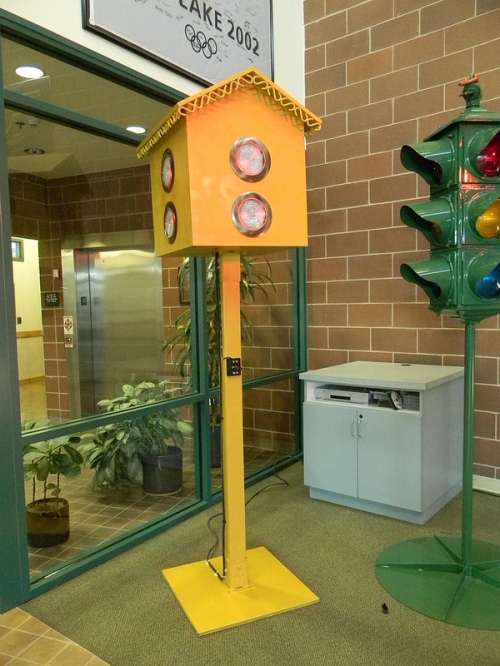
Replica of the first traffic light (although this appears to use all red lenses). Utah Department of Transportation, CC License.
From the 1950s on, even the 8” lenses were becoming too small for the higher speed, higher volume, wider roads becoming in use, so the 12” version was introduced. (And of course signals companies were eager to sell bigger, more expensive traffic signals. The Crouse-Hinds “type K”, which had 12” red lenses, was the first. Arrows were hard to see in 8” so they quickly increase in size, the green and yellow balls were slower to be changed out. To this day 8” indications are permitted where the speed limit it 30 mph or less, and some agencies, including New York, take advantage of that.
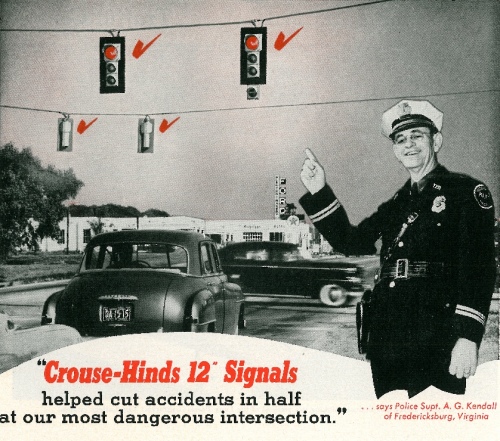
1957 Crouse-Hinds advertisement for the new 12″ signals
Why Red, Yellow, and Green?
These are copied from railroad signaling. Red is the obvious choice for “stop”, since being the color of blood it has meant “danger” since time immemorial. The original choice for “caution” was green, and “go” was white. (I’d speculate green was chosen at random because it was noticeably different from red, and a green filter was more efficient than say blue or purple. Probably they just didn’t hire colorblind engineers). The obvious problem is you have a “fail deadly” situation if the red filter doesn’t engage or the lens falls off, which supposedly actually happened around 1914 causing a crash. A second problem was even back then there were a lot of white lights around making it hard to tell a “go” signal from a light in a barn. When the colors were reassigned, they kept green and made it “go”, and added yellow as “caution”. The meaning of those colors entered culture because of signal lights, not the other way around.
Two section vs Three section
The yellow “caution” indication was an option almost from the beginning, but with slower and lighter traffic in those days some agencies decided it was an unnecessary expense, and dispensed with it. Notably New York City primarily installed two section displays up to 1952 (In defiance of a federal ban in 1935) , some of which persisted into the 1980s. Sometimes the signal would go dark to signal a phase change, but later both lights would illuminate, and red and green blended together to form yellow farther back. Perhaps the ultimate in cheap was the two lamp Darley. There was one lamp in each section, with red on top for the main street and green on top for the side street. Each lamp was projected in all four directions, so the top section would show red for the main street and green for the side street simultaneously. A simple three position controller was included in the light, so all the city had to do was hang it and hook up mains power.
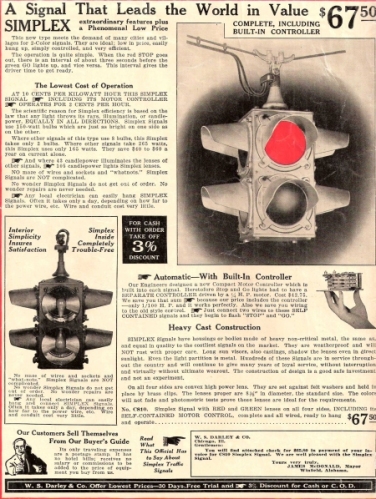
The Acme, Wiley, and Mercury Signals.
Los Angeles, San Francisco, and New York each had unique designs specific to that city. Los Angeles had the Acmes, which in addition to the lights had a bell and the stop/go flags which would come out of the housing- you see these in old Hollywood movies and cartoons. Wiley “birdcage” signals were in San Francisco, and had lighted red and green “stop” and “go” panels that rotate around. New York had the Mercury signals, with conventional red and green lights, but made of bronze, very ornate, and with a statue of the goddess Mercury on top. The Mercury signals were all destroyed by New York City, although a few of the statues survived. There are a few Acmes and Wileys around in private collections, and they normally fetch 5 figures when sold.
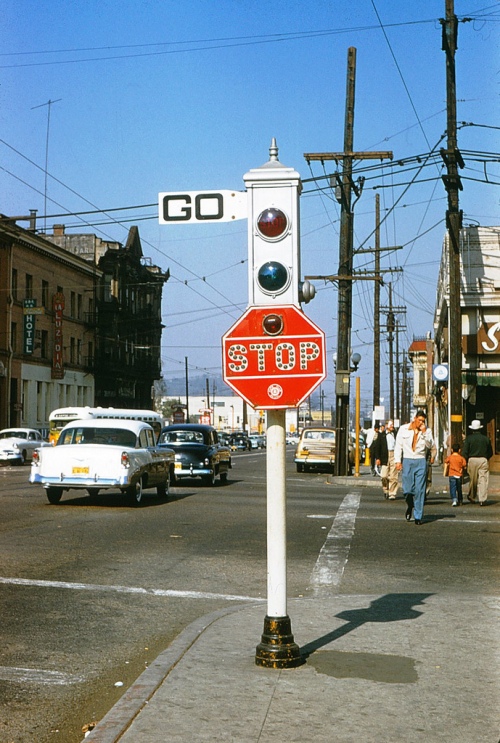
Acme Traffic Signal. Late at night the large red and green lights would go out, and the small red light in the stop sign would flash indicating a four-way stop. Alan Weeks, Metro Library and Archive, CC License
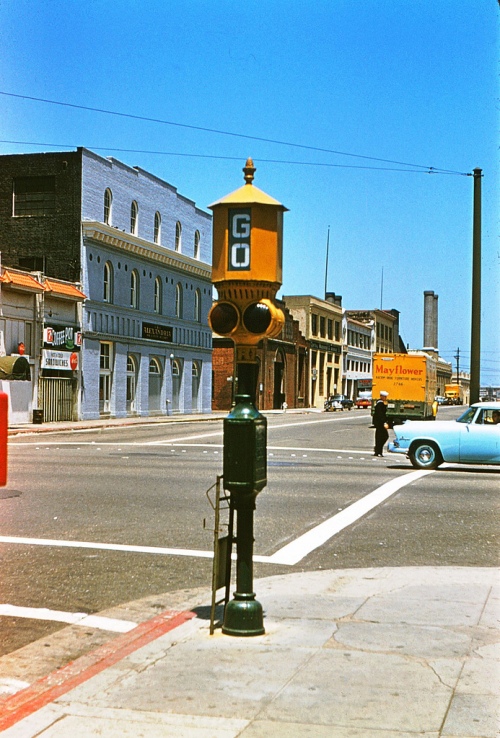
Wiley “Birdcage” signal. the top was internally lit, and a rotating drum would change each side between stop and go. Metro Library and Archive, CC License
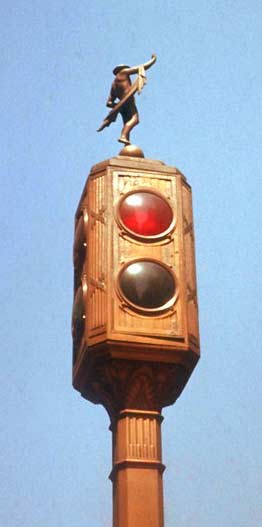
Mercury Signal, Photographer unkown
Traffic Signal Lamps
Signals always have and most still do run on mains electricity (although some of the very newest ones run on 48 volts DC). The lamps are specialized incandescent lamps optimized for long life and an even light dispersion rather than efficiency. 8” and 9″ signals would use 69 watt lamps, 12” and 16″ would normally use 116-150 watt versions, although often yellow balls, which pass more light through the lens than other colors, would use 69 watts.
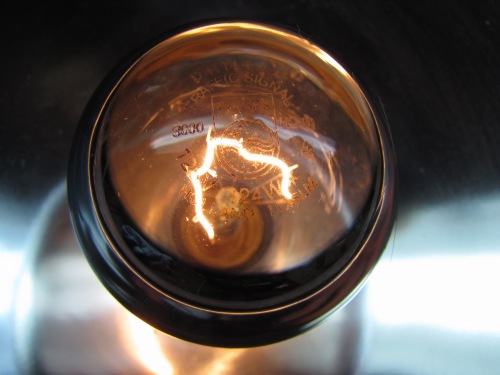
Traffic signal bulb. The filament is supported in a way that throws light down towards the reflector. Not all of them have this silvered band around the middle which helps the lens light more evenly.
Paint Colors
Originally signals tended to be black, green, or bare aluminum. The yellow as used here and other areas comes from a 1950s Manual of Uniform Traffic Control Devices recommendation that was eventually removed. Yellow makes the overall installation more visible, but black provides more contrast making the indications easier to see. Minnesota used the best of both colors by using yellow bodies and black doors. Poles here were also traditionally painted yellow. Mn/DOT and most counties have recently switched from yellow aluminum signals and painted steel poles to black polycarbonate signals and galvanized steel poles that need no paint.
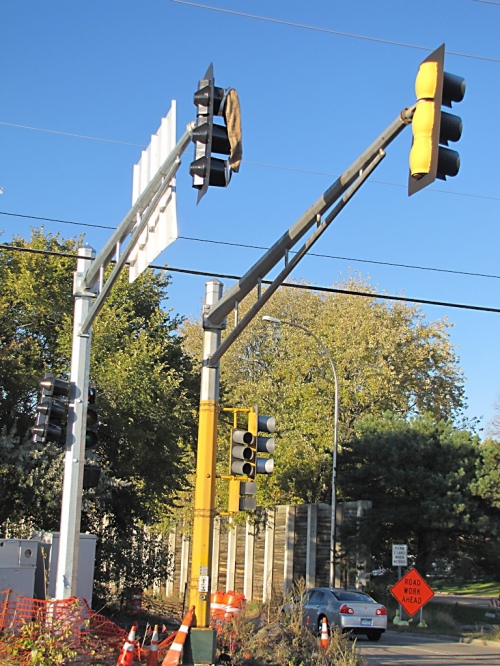
Old and new Mn/DOT standard signals, 90th and I-35W, Bloomington
The Future
Even the new LED indications mimic the same basic three “lamp” configuration that’s more than 100 years old even with the different abilities of LEDs. Other nations have been more adventurous- Asia has animated pedestrian “mans” that speed up as the time counts down. For vehicles they horizontal bars that light up red, yellow, or green that as needed, and shrink as the time expires. In Germany pedestrians can even play a game on the push-buttons with the person across the street. One proposal for the US that made it into prototype was the “Unilight” that used a single section to light up a red square, yellow diamond, or green circle. There’s been various proposals that would give drivers feedback as to how much red and green time they have left (presumably for pre-timed installations only). And perhaps with self-driving cars and smartphones the overhead installations will go away entirely save for a single indication for those still driving “manual” cars.
A Spotter’s Guide to Traffic Signals
September 2, 2016 at 5:00 pm | Posted in Traffic Signals | Leave a commentTags: +Stoplight, +Traffic Signal
Eaglelux KB63 “Tall Fin” and “Short Fin”
The Eagle Signal company is one of of the oldest of the signal companies, located in the Quad Cities for many years. And the oldest signals still in place in Minneapolis are the Eagleluxes, which was the original Eagle trade name for their signals. (This area has long shown a strong preference for their equipment). Although a lot have been discarded in the recent traffic signal timing project, there still are some left, many with incandescent yellow. The most distinguishing feature of them is the art-deco like fins on the top and bottom plate. (Early sectional signals had open tops and bottom to each segment, there’s be an end plate on each end and tie rods holding the entire thing together.)
These were made from the 1930s to the mid-1950s. Early KB63s, the “Tall Fin” have a brass ID tag (normally covered by years of paint) on the bottom plate and no logo on the backs. Later there were running production changes where the fins were noticeably shortened, the Eagle logo was added to the back, and the ID plate was removed, and the fins were noticeably shortened The reason for this is speculated to be that the long fins interfered with more modern mounting hardware that was coming into use. This configuration is known to enthusiasts as the “Short Fin”.
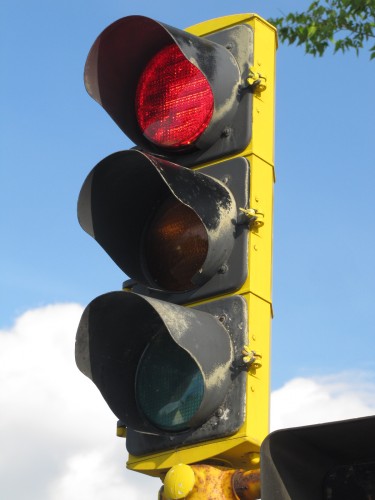
Eaglelux “Tall Fin”, Minnehaha Ave and 46th St, Minneapolis

Eaglelux “Short Fins”, Minnehaha Parkway and 50th St, Minneapolis
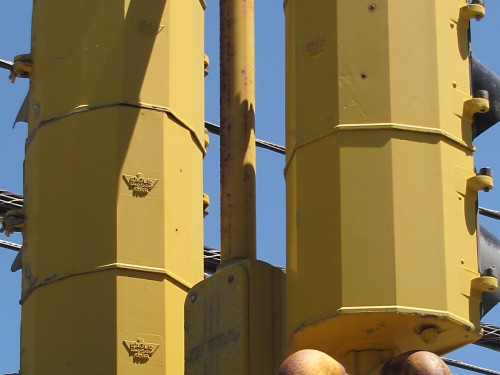
Eaglelux backs. This is the mix of early (no logo) and late (with logo) sections and late (short fins) top and bottom plates
Eagle “Rodded Flatback”
In the mid 1950s, Eagle dropped the Eaglelux name and introduced the “Rodded Flatback”. This was somewhat of a transition that was only in production for a few years. It introduced the simplified body style that would last for many years, but maintained the use of top and bottom plates, (now with no fins) with tie rods and the older style “slam latch” reflectors, and old small logo. I don’t know of any that are in the field, but list it as there might be, and since it is interesting as a transition to the more modern style. Also of note this is the first that had dedicated 9” square pedestrian housings. Before if you wanted pedestrian indications you added a 4th sections to the vehicle section and installed a black and white circular “Walk” lens, or later on a separate 2-light signal with an orange “Wait” and white “Walk”.
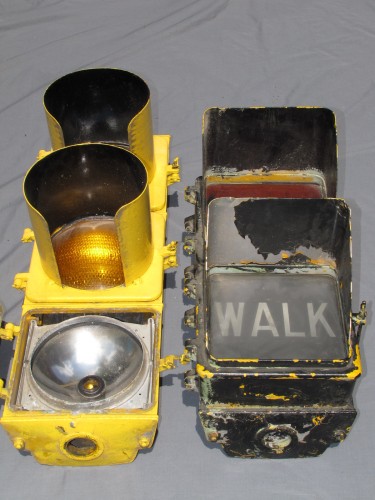
Eagle “Rodded Flatbacks” from my personal collection
Eagle KB170 / KB380 “Flatback”
In 1960 Eagle introduced this model, Gone are the tie rods and plates, all sections now have tops and bottoms and are held in place by internal clamps, and the reflector was a modern “H” shape. The small Eagle logo was replaced with a much larger version. The initial production had a large trapezoid above and below the eagle, enthusiasts call these these “Trapezoid Flatbacks” and only they only lasted a few years before the trapezoids were removed (the reason for them is not known).
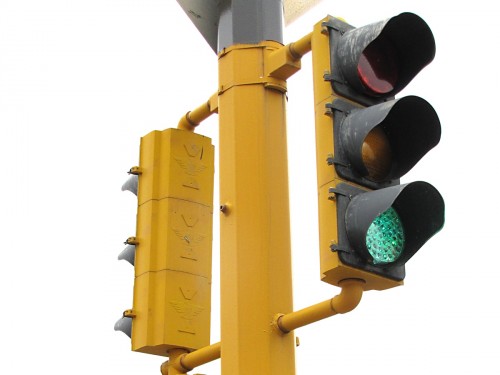
Eagle “Trapezoid Flatback, W 7th St, St. Paul. This is the only one I’ve seen in the field
Although the 8″ variety are most common, in the 1950s 12” indications were introduced and promoted by the signal companies as being more visible on the newer higher speed roads and more complicated intersections. Initially only the reds were 12”, and only on overhead mountings (which became increasingly common during that time)- 8” and 12” sections have always been able to fit together. Later all three sections were 12” (and now 8” are only allowed on lower speed roads). Eagle’s version was designated model KB380 and besides the obvious size difference looks similar to the 8”. Some KB380s are found on older installations in Minneapolis and the suburbs, but they are not overly common.
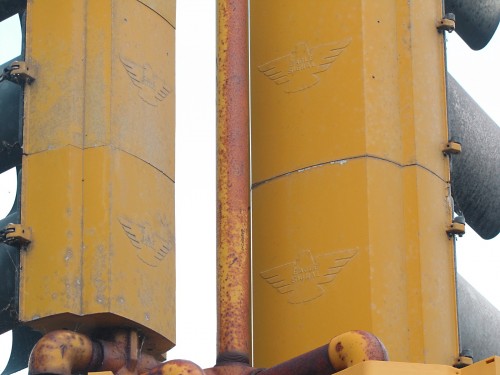
Eagle “Flatback” backs
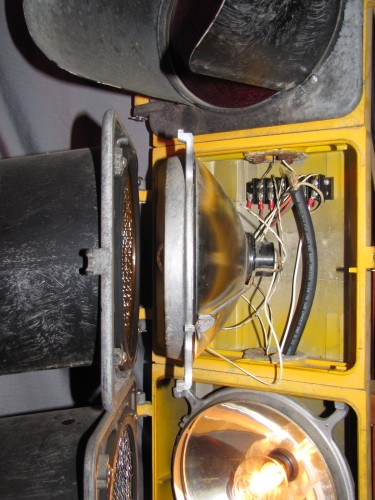
Eagle “Flatback” internals. Virtually all traffic signals still have a similar design. From my personal collection
Eagle AluSig and DuraSig
In the early 1970s there was a radical redesign. With catchy trade names came a move to internal hinges, and thumbscrews instead of latches to hold the doors closed. AluSig was made of traditional aluminum, and DuraSig introduced a new material- polycarbonate. Minneapolis and St. Paul were quick to adopt polycarbonate, the other agencies and Mn/DOT were very slow to and only recently have switched. The early DuraSigs had an unfortunate design in that the reflector was attached to the door, which made it difficult to change the reflector or lens, as well as visors attached with fragile tabs instead of screw. They were later revised to a more conventional design. DuraSigs worked well up here where they were immune from salt spray, but tended to bake and become brittle in warmer climates.
Both 8” and 12” DuraSigs were wildly popular in the cities, and the 12” versions are still being installed. AluSigs were more popular with Mn/DOT and the suburbs, even then they were mainly using 12”, so 8” AluSigs are uncommon, and when found are normally a pedestrian signal or the yellow and green of a larger assembly.
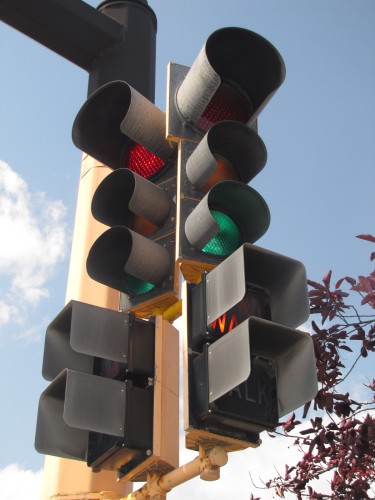
Eagle Alusig 8″ and 12″ combo. The 9″ worded, incandescent pedestrian signals are virtually extinct. 65th and Lyndale Ave, Richfield

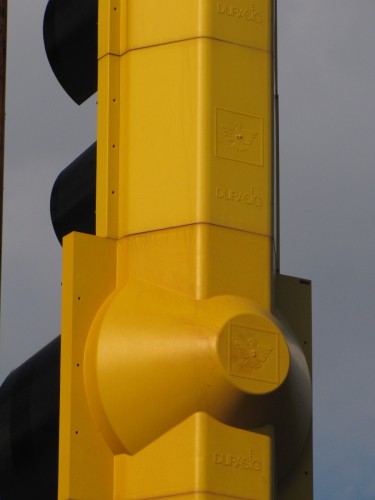
Durasig Backs
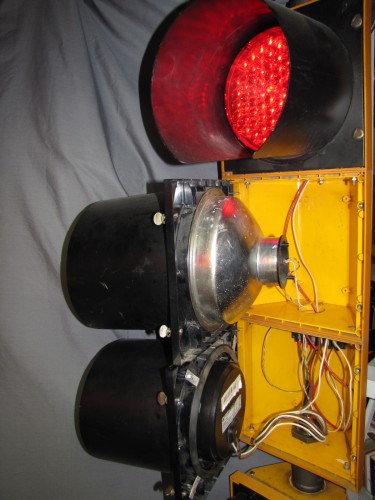
Durasig front and internals from my personal collection. The red and green are LEDs.
Later Eagle Models
In 1987 Eagle was bought by a company called Mark IV Industries. Shortly before this Mark IV had also bought out Automatic Signal. Each company had 8” and 12” vehicle and pedestrian signals in poly and aluminum, so a total of 24 products, so simplification was inevitable.The following products survived the merger:
- Eagle Alusig, 9″ pedestrian only as type SA, later discontinued
- Eagle DuraSig, 9″ and 12″ pedestrian and 8″ and 12″ vehicle as type SA
- Automatic polycarbonate, 8″ and 12″ vehicle as type SIG, 8
- Mark IV aluminum, 12″ pedestrian and 8″ and 12″ vehicle as type SIG, 8″ vehicle later discontinued.
“SIG” is known as “SG” with LEDs, and now can only be ordered that way. Of these types, SA continued to be used in the cities, while Mn/DOT and the suburbs switched to aluminum SIG exclusively, (referred to by enthusiasts as “Bubblebacks”). Mn/DOT finally switched to polycarbonate a few years ago, and suburban agencies followed, so now we’re starting to see type SA in the suburbs.
Siemens bought Mark IV’s signal products in 1997, discontinued the Eagle name, and moved Eagle away from the Quad Cities to Texas. In 2013 Siemens sold Eagle’s signal head business to a company called Brown Traffic (while keeping the more profitable control business). Brown has indicated they plan to re-introduce the Eagle name, and update the molds to the new Eagle logo, which is a realistic perched eagle rather than the stylized “Thunderbird” of the past 50 years. The headquarters has returned to the Quad Cities, although manufacturing will likely stay in Texas.
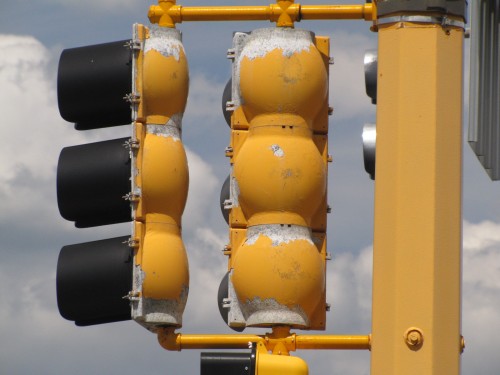
Type SIG “Bubblebacks, later version, 98th and Dupont Ave / I-35W, Bloomington. Eagle visors tend to point downwards more than other brands.
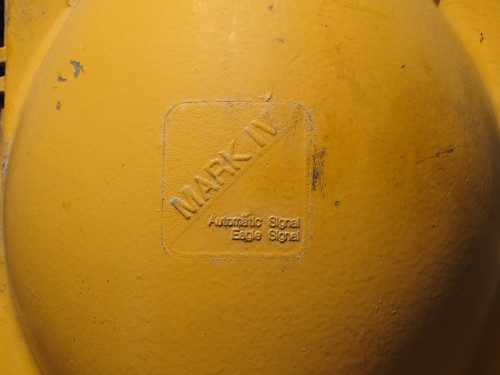
Early Bubbleback before the logos on the backs were removed about the time of the Siemens buyout. After this the backs were unmarked and there was “EAGLE” spelled out on in small letters on the top where it’s impossible to see from the street. From my personal collection
Econolite (and GE) Products
Econolite is based out of California. They’re most noted by enthusiasts for producing a line of neon pedestrian signals that were ubiquitous in California (now virtually all gone), as well as distinctive looking vehicle signals. They got into the vehicle signal business in the early 1950s when General Electric, one of the early players, changed their design and sold them their old molds (In 1957 GE would exit the business entirely and sell them the remainder). I’ve seen 1950s-early 2000s Econolite products used here; there are some in St. Paul, but they tended to be used more in the suburbs.
GE, and later Econolite 8” signals were rather distinctive in that there were vertical grooves running down the back. A late 1950s production change was to shorten the grooves so they didn’t go all the way to the end of the section due to water ingress problems. Enthusiasts refer to these as “Groove Back”, “Long Groove” and Short Groove”. The corresponding 12” signals were circular and had a concentric design, “bullet backs”, and could come with either round or square doors. (Econolite models numbers were E31 for 8″, T31 or ST31 for 12″, and C35 or SC35 for a combination, the “S” denoted square doors rather than round) These designs lasted until the early 1980s, when “Buttonback” 12” signals debuted. “Buttonbacks” lasted until the early 2000s. These were the last Econolite products I’ve seen used here.
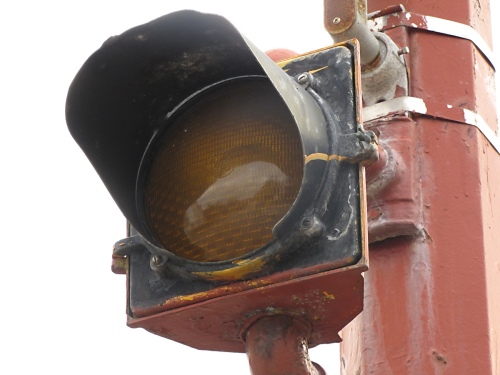
This is the only piece of GE equipment I’ve seen on the streets in Minnesota, a long defunct flasher on Vermillion Street in Hastings.

Pair of GE signals in Heritage Square at the Minnesota State Fair. In the 1940s GE signals came with beautiful “Spiderweb” lenses. With Heritage Square demolished I don’t know the fate of these
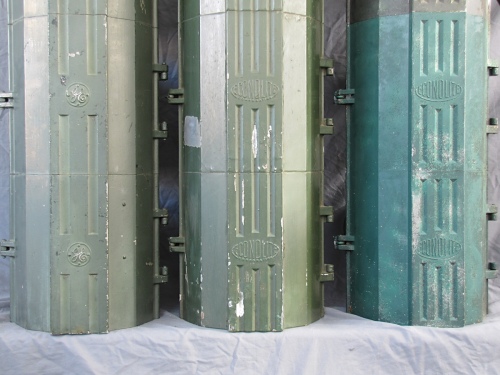
8″ back styles for GE, left; early Econolite, center, and later Econolite, right. From my personal collection.
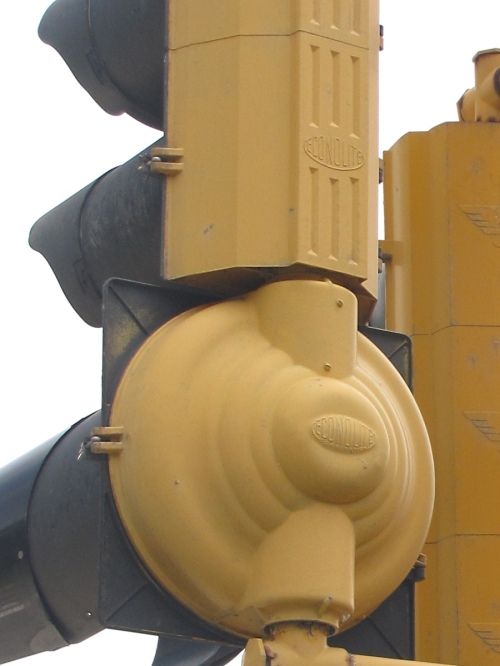
Econolite SC35 “Bullet back” and “Short Groove” signal, 7th St and Montreal Ave, St. Paul.
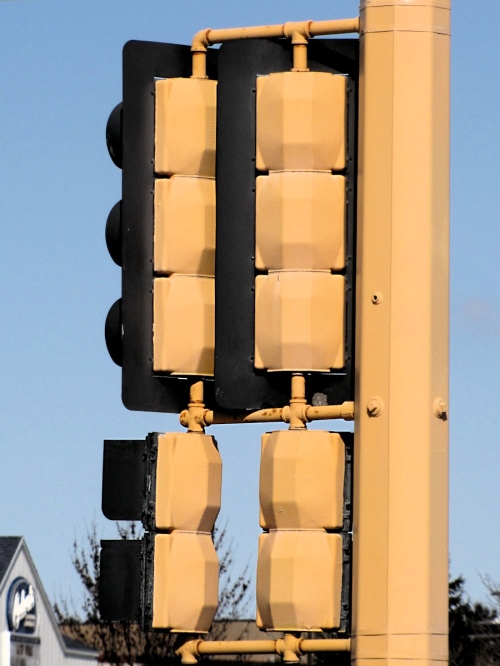
Econolite “Buttonbacks”, Market Drive and Curve Crest Boulevard, Stillwater. These are very rare here, and later Econolite products (which look much like the McCain signals described below) are not used at all.

Econolite “C35” (actually pieced together from different lights), along with an Econolite E8 neon pedestrian signal, this configuration was iconic of California for decades. From my personal collection.
McCain Signals
In the past decade or so McCain polycarbonate signals have been showing up. They’re very plain looking, but they do the job. 8″ models are often used as ramp meters. Except for a smaller size they are identical.
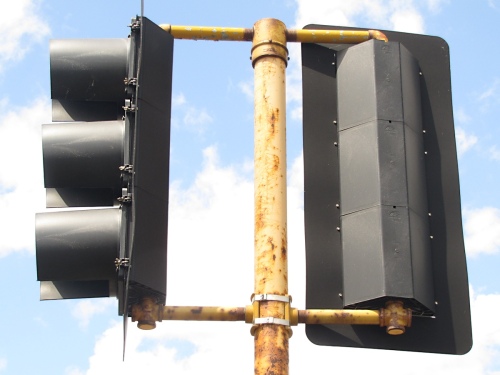
McCain 12″ vehicle signals, County 10 and County H, Mounds View
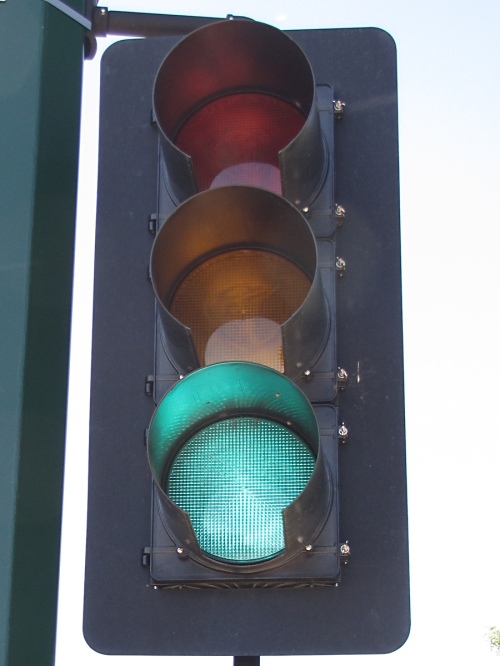
McCain 12″ vehicle signals, County 10 and County H, Mounds View
Programmable Visibility Signals
In their own category are “programmable visibility” (PV) signals for when it’s desired to only allow it to be seen from a narrow viewpoint, for instance two roads the meet at a sharp angle.
3M Model 131, introduced in 1969, was the first of this design. Rather than a conventional traffic signal bulb (which resembles a standard clear incandescent), these used a compact, high intensity PAR lamps that was accessed from the back. The light from the bulb went through a frosted diffuser, and then a clear optical limiter lens, followed by the acrylic tinted Fresnel lens in the front. The whole assembly could also be tilted at different angles. How it worked is once the light was mounted, you’d go up in a bucket truck and peer through the optical limiter toward the road, seeing an inverted image of the road. You’d then put a special 3M tape (more or less heavy duty duct tape) on the optical limiter to cover parts of the road you didn’t want to see the light.
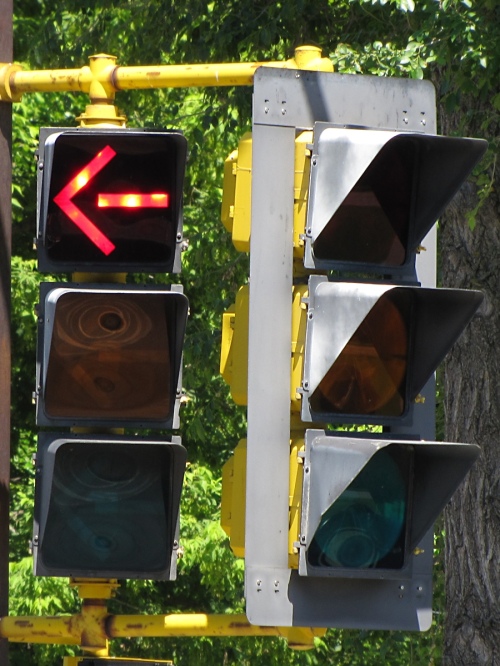
Front view of 3M traffic signals, Trunk Highway 121 and 58th St, Minneapolis

3M 131 internals, front view. The top section has the wire guard and diffuser in place, the bottom section has them removed. The white object in the background of the bottom section is the lamp. Normally there would be a pole adapter on bottom, which I removed to make it sit flat on a table. Also missing is the dimmer, which would fit on the lower left. These would automatically dim the light at night, but were stripped out during LED conversions as they were not compatible.
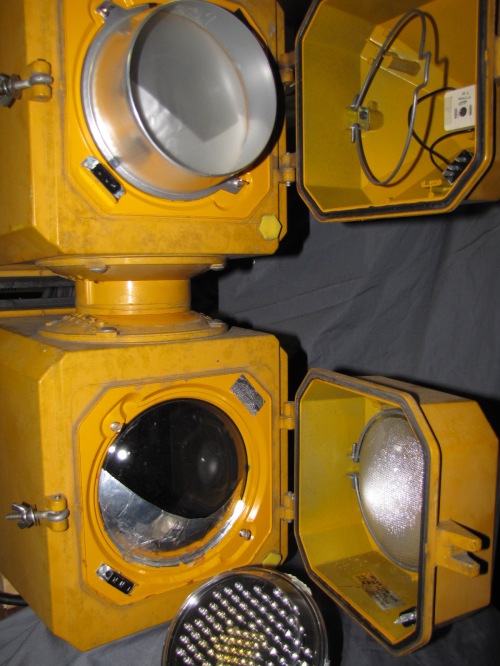
3M 131 internals rear view. Top: bulb removed, diffuser present. Bottom: Bulb present, diffuser removed. This is masked so you can see it close-up but not farther away, as might be used in two intersections really close to each other. An LED retrofit bulb is on the table.
Eventually McCain introduced their own PV signal to compete directly with 3M. They looked similar, except for the back (which is actually a re-purposed 8” section) and using standard circular visors. This area was never enthusiastic about them, preferring to support the local company. However competition and declining orders eventually led 3M to discontinue their model in 2007 so for a while McCain was the only PV option.
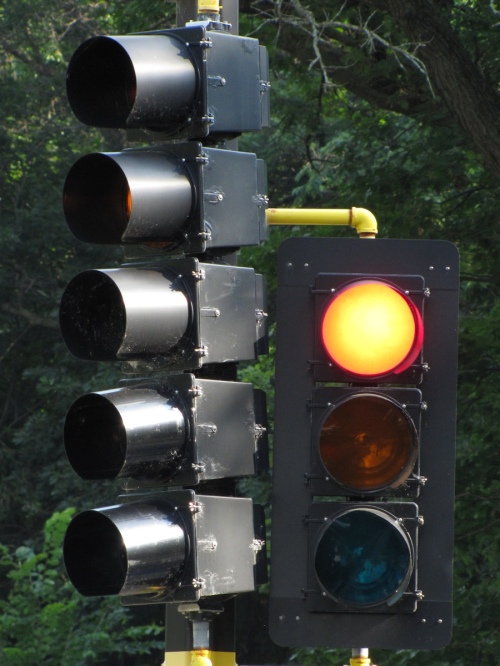
McCain PV signals, Calhoun Pkwy and William Berry Dr, Minneapolis
As a more modern alternative, a company called Intelight offers “electronically programmable” signals. Basically rather than a few high powered LEDs as used in most signals, there are a large number of standard LEDs in a grid. These can be selectively disabled through software to restrict the visibility, generally done by a smartphone app by a worker in the street. These have large heatsinks on the back and so are hard to mistake for anything else.
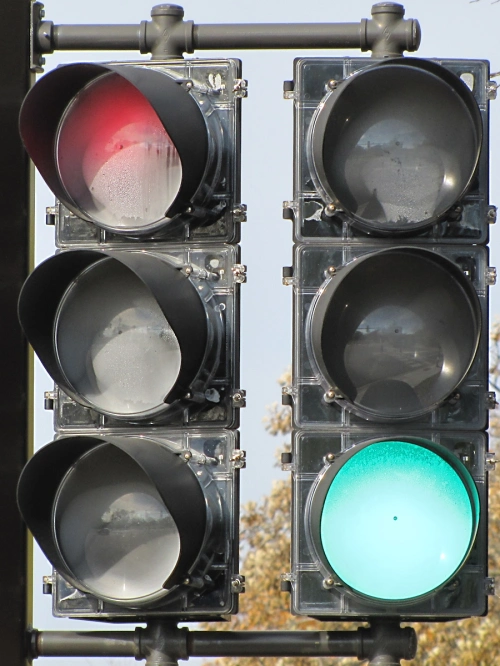
Intelight fronts, Franklin Ave. and East River Parkway, Minneapolis
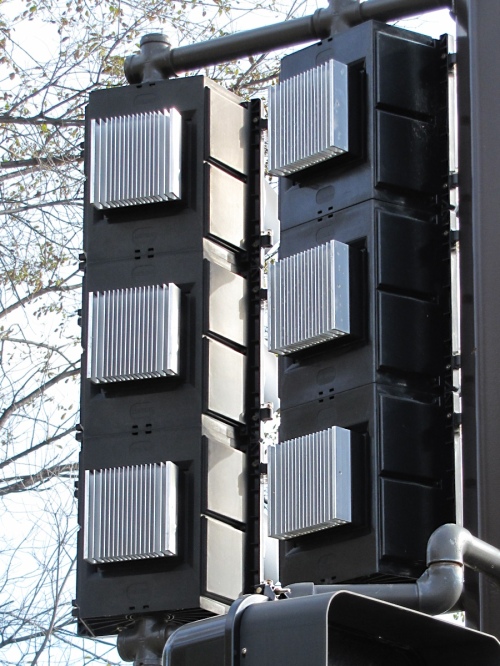
Intelight backs.
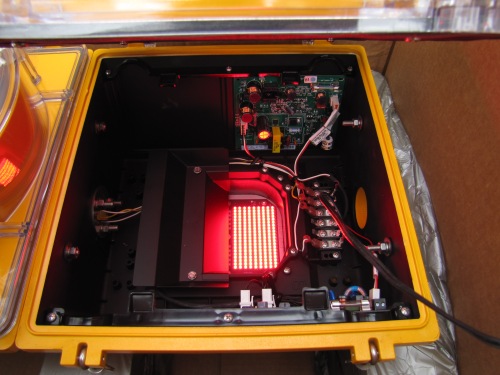
Intellight internals
This concludes the spotters guide. I’ve left out products by a number of companies that have only a minuscule share of the equipment here, but what I have have included amounts to well over 99% of the equipment in service in Minnesota
Website Powered by WordPress.com.
Entries and comments feeds.




